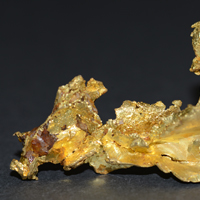Art, Artifacts and Specimens from the Collectors Cabinet
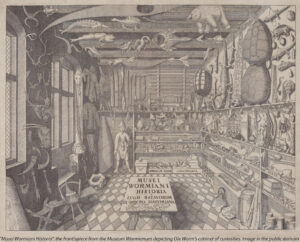
Originally, collectors cabinets were rooms full of various works of art, natural history objects, and antiquities first organized during the Italian Renaissance. Ole Worm, a Danish physician and professor at the University of Copenhagen, assembled the one shown here during the early 1600s. Some cabinets demonstrated the power and wealth of the owner, challenging the viewer to think about the connections among what might today seem to be randomly-arranged objects. Cabinets became a popular way to display objects from travels or items of personal interest. Collectors evolved into curators, classifying and interpreting the wide-ranging collections. In the same fashion, the series of cabinets or rooms of objects were the genesis of today’s museums. This exhibition reflects the legacy of collectors, donors, and curators who had an affinity for or relationship with the University of Delaware.
Unless otherwise specified, all the objects and specimens on view are from the Museums Collections.
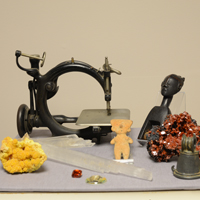
In the Beginning
Although this exhibition is arranged thematically, where objects in the cases relate to one another, it is important to understand that collectors cabinets from the Italian Renaissance onward were arranged in a random fashion. Unrelated objects arrayed in a room, drawer, or cabinet spoke to the eclectic interests and idiosyncrasies of each specific collector. This case is designed to reflect this type of unplanned display and to act as a gateway of sorts in understanding the origins of these cabinets.
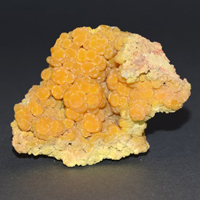
Mimetite
Mimetite
Congreso-Leon mine, San Pedro Corralitos, Chihuahua, Mexico
3 x 4 x 2 inches
Estate of Frederick A. Keidel
The Congreso-Leon mine operated for about sixty years as a lead and zinc mine, closing in the 1950s. In 1968, Benny Fenn, a mineral dealer, descended 900 feet on ropes into the old and dangerous mine. He started digging in a wall, following a vein of mimetite until it opened into a room 40 feet long and 30 feet tall, its walls lined with yellow botryoidal mimetite. Over a three-month period, Fenn collected and carefully wrapped two tons of specimens and had a hoist system to bring them to the surface.
More about this item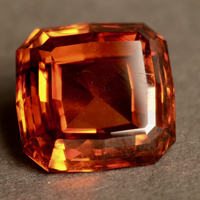
Sphalerite
Sphalerite
Spain
18.2 x 18.2 x 9.1 mm, 36.14 carats
Gift of John M. Levinson
Sphalerite, the major ore of zinc, is rarely transparent. This square cushion-cut sphalerite is of very good clarity and excellent cut. Because it is soft, it is difficult to cut; therefore, it is not a wearable gemstone, but attests to the skill of the cutter.
More about this item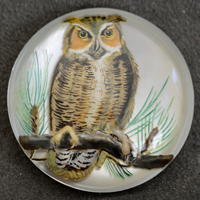
Owl Reverse Intaglio
Erwin Pauley (Idar-Oberstein, Germany, b. 1934)
Owl Reverse Intaglio, 20th century
38 x 38 x 8 mm
Gift of Mr. and Mrs. Harold B. Frosh
The art of glyptography (gem engraving) originated in Belgium in the 1860s. It includes both intaglios, in which the material is engraved, and cameos, in which the material is carved in relief. The round, quartz cabochon front with reverse intaglio carving of an owl on a pine branch has been incised into the quartz from the underside and then painted. The carving is backed with mother of pearl.
More about this item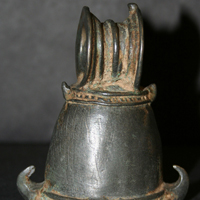
Bell
Unknown Artist
Thailand
Bell, 19th-20th century
Bronze, 3 inches high x 2 1/8 inches diameter
Gift of Mr. and Mrs. Samuel Eilenberg
In many cultures, bells are used to call people to prayer, worship, or merely as attention-getters. Not much is known about this bell, but its construction evokes an architectural form, possibly the eaves of a Thai temple, seen in the upcurled finials and the bell’s elongated shape. Its size suggests it was likely used by an individual, or hung around an animal’s neck.
More about this item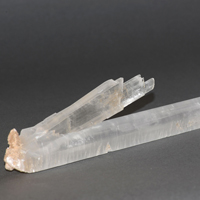
Gypsum
Gypsum
Cave of Swords, Naica, Chihuahua, Mexico
2 1/4 x 13 x 1 inches
In 1910 a mining company discovered a huge cave of gypsum that became known as the Cave of Swords. It is connected to the Naica mine at a depth of 390 feet, with crystals up to six feet in length. Unfortunately, over the years tourists removed or damaged the specimens. Years later, in 2000, another cave, the Cave of Crystals, was discovered under the Cave of Swords at a depth of 980 feet with even larger crystals. Professional filming was done at the time, recording the extreme size and beauty of the crystals. Afterward, the water pumps were removed and the cave was allowed to flood. Over time these crystals will continue to grow.
More about this item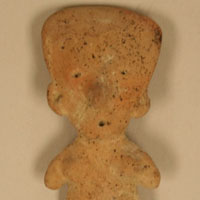
Female Figure
Unknown Nayarit Artist
Colima/Jalisco, Western Mexico
Female Figure, 500-400 BCE
Terracotta, 4 1/2 x 1 7/8 x 1 3/8 inches
Gift of Geneva R. Steinberger
This type of ancient figure is identified with Nayarit, both a culture and a location in Western Mexico. Some figures from this period and region appear abstract, characterized by puffy, slit-like eyes and broad rectangular or triangular heads. These figures are often shown seated or reclining, with shortened bulbous legs quickly tapering to points, much like the one shown here.
More about this item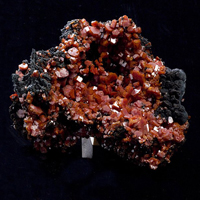
Vanadinite
Vanadinite
Er Rachidia Province, Taouz, Morocco
4 x 4 1/2 x 3 inches
Gift of Margaret O. Plank
The vanadinite was found in the early 1980s before the more famous and prolific finds in Mibladen, Morocco. The caves, in a hot desert near the Libyan border, had tunnels dug by hand and the specimens were collected from these unsupported dangerous workings.
More about this item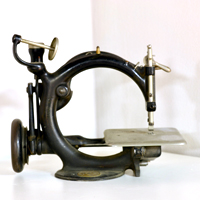
Hand Sewing Machine
Willcox and Gibbs
Great Britain
Hand Sewing Machine, mid-19th century
Black enameled iron, 8 7/8 x 10 1/2 inches
Permanent loan by Dr. Mary Bartlett Cowdrey
James E. A. Gibbs and James Willcox opened the Willcox & Gibbs Sewing Machine Company in 1857. Its London Office opened in 1859 at 135 Regent Street, a fashionable shopping district. The sewing machine’s circular design was so popular that it was produced well into the early 20th century, long after most machines were of the more conventional squared arm design. Unlike other types of machines, this machine employs the Gibbs rotary-twisted chain stitch in which the stitching was less prone to becoming unraveled.
More about this item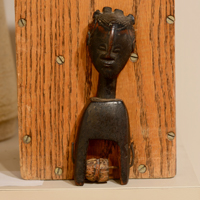
Heddle Pulley
Unknown Guro Artist
Côte d’Ivoire, Africa
Heddle Pulley, 19th-20th century
Wood, patination, 7 1/8 x 2 1/4 x 1 1/4 inches
Gift of Julius Carlebach
Guro live west of the Baule on the Côte d’Ivoire, in a heterogeneous area of tree-filled savannas and dense tropical forest. This heddle pulley held fibers for weaving strip cloth. The narrow strips were joined to make cloth drapes used in garments and wrapped headgear. The heddle usually was hung in a tree or on a bush, allowing the weaver to maximize the length of the strip cloth and to maintain tension, assuring an even and taut weave.
More about this item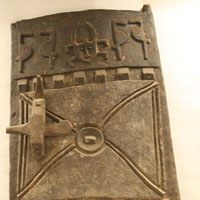
Door
Unknown Senufo Carver
Côte d’Ivoire, Africa
Door, early 20th century
Wood, 52 1/2 x 28 1/2 x 4 inches
Gift of Mr. Samuel Rubin
The Senufo often revered doors of this type as prestige objects, which served a religious function of separating the sacred from the secular. This door is divided into three registers. At the top is a mask, representing the male secret society Poro, shown flanked by twinned birds identified as hornbills. At the center is a representation of the female abdomen with scarification patterns radiating outward from the navel. At the bottom, the twinned hornbills are once again flanking a tortoise, which like the hornbill, represents fertility. The door could also have functioned as a granary door in protecting the precious harvest from thieves or animals.
More about this item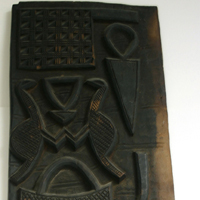
Nupe Door
Sakiwa the Younger (Lapai Nigeria, Africa, dates unknown)
Nupe Door, 1920-1940 or later
Wood, 70 x 15 inches
Gift of Geneva R. Steinberger
Indigenous people in the highlands near the Nigeria-Cameroon border carve Nupe doors. The carving programs on these doors represent families, energy, and household belongings. Some of these doors were used on native houses and some were used in religious rituals. Most Nupe doors join several planks together, but this partial door shows only one plank, and the lighter edge suggests other planks would have been joined to it. Like many Nupe doors, there is a combination of forms in the surface carvings, including animals such as the ostrich, and everyday tools like the saw and anvil.
More about this item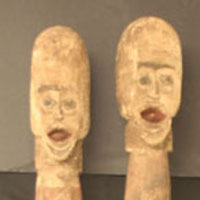
Posts of Doorframe
Unknown Bamileke/Fang Carver
Cameroon, Africa
Posts of Doorframe, mid-20th century
Wood, polychrome, 82 1/2 x 9 1/8 x 5 inches
Gift of William C. Lickle
In the Bantu language, the word for door can also be translated as mouth. The faces seen on this house doorpost are similar in character to the Fang masks called Ngongtang, but they also have the elongation of the Bamileke Ngil (gorilla) masks. Although these two types of masks have different significance to the two cultural groups, for both the Fang and the Bamileke, this doorframe dually serves as a sentinel and warning, warding off the entry of evildoers or witches.
More about this item
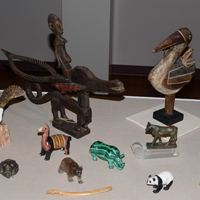
Animals
Animals have served as lifelong companions and have provided enduring sources of artistic depiction, curiosity, and symbols of magic.
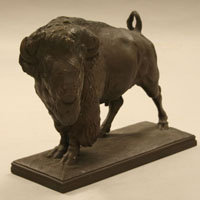
Buffalo
Alexander Phimister Proctor (United States, 1862-1950)
Buffalo, 1912
Bronze, 20 x 13 5/8 inches
Gift of the Gorham Corporation
Alexander Phimister Proctor created four immense sculptures of buffalo to adorn the Dumbarton—or Q Street—Bridge in Washington, DC. The Gorham Foundry cast several models with inscriptions indicating the Buffalo was a model for the Q Street Bridge sculptures. This cast additionally has the founder’s mark and 1912 on its base.
More about this item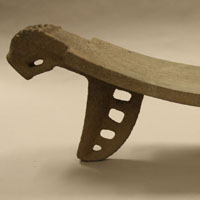
Jaguar Effigy Metate
Unknown Nicoya Maker
Northwest Costa Rica
Jaguar Effigy Metate, 4th-8th century
Stone, 32 1/8 x 11 7/8 inches
Gift of William C. Lickle
This decorative grinding stone features a composite serpent-jaguar head and a tripod of openwork legs. It is hewn from a densely-grained volcanic rock. The metate is a base on which corn, for example, is ground into meal using a lozenge-shaped stone to roll and crush the kernels.
More about this item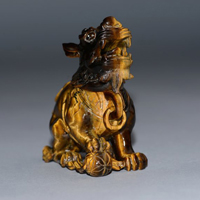
Guardian Lion
Unknown Carver
China
Guardian Lion, 20th century
Tiger eye, 2 3/4 x 3 1/2 inches
The Chinese guardian lion incense burner, made of tiger eye, has a separately carved head with an open mouth with carved teeth and tongue. One paw rests on a carved ball, and a free-swinging ring that hangs from the chest ring is carved from one continuous piece. Chinese lions, also called Imperial Lions or Foo Dogs, were originally made of stone, and were used in large pairs for the protection of buildings.
More about this item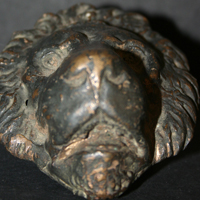
Decorative Lion Head
Unknown Artist
Italy
Decorative Lion Head, 15th-17th century
Bronze, 2 1/2 x 2 7/8 x 3 5/8 inches
Gift of Mr. Alan Gerdau
Although donor Alan Gerdau collected many artifacts from Padua, Italy, it is possible that this decorative bronze originated in Venice. The lion is the attribute of Saint Mark, the city’s patron saint, and is ubiquitous throughout Venice. It appears as fountain spouts, doorknockers, and architectural decoration. This small head could have functioned in any of those ways, but considering the wear of the patinaed surface, and the partial brackets on the back, this was probably a doorknocker.
More about this item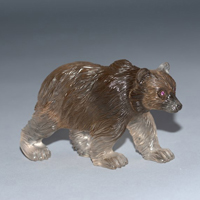
Grizzly Bear
Robert Juchem (Idar-Oberstein, Germany, dates unknown)
Grizzly Bear, 20th century
Quartz, 2 3/4 x 5 x 1 3/4 inches
Gift of Mrs. David Craven
The walking grizzly bear is carved from one piece of transparent colorless quartz and has carved fur and ruby eyes.
More about this item
Chameleon Knife (or knife handle)
Unknown Maker
Egypto-Roman (Coptic)
Chameleon Knife (or knife handle), ca. 150 CE
Bone, 8 1/4 x 3/4 inches
Unknown Donor
In the Egypto-Roman or Coptic period, bone was used extensively for utensils including spoons, combs, and ornaments used in hairdressing. This knife (possibly a handle) in the form of a chameleon was made from animal bone, likely from Egyptian cattle that grazed the banks of the Nile and were found in the Fayum Oasis region west of Cairo. The Akkadians, an ancient culture that dominated modern-day Iraq over 4,000 years ago, named the chameleon nes qaqqari, literally “lion of the ground.” This usage continued through subsequent civilizations over the ensuing centuries. In modern English “chameleon” means “ground lion.”
More about this item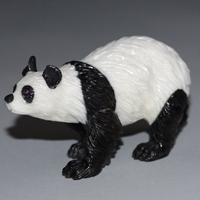
Panda
Unknown Carver
China
Panda, 20th century
Dolomite and obsidian, 2 1/4 x 4 x 1 1/2 inch
The panda is carved from white dolomite and black obsidian and has applied ears, nose, and eye patches.
More about this item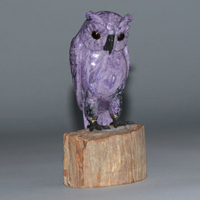
Owl
Unknown Carver
Owl, 20th century
Charoite, 2 1/2 x 5 1/4 x 2 inches
Estate of Mrs. David Craven
The owl is carved from one piece of purple charoite, mined only near the Chara River in Siberia, Russia. With a separate agate beak and eyes, and cast-silver feet, the owl sits on a petrified log cross-section.
More about this item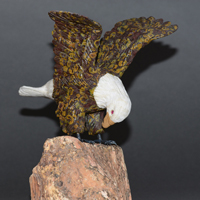
Bald Eagle
Robert Juchem (Idar-Oberstein, Germany, dates unknown)
Bald Eagle
Jasper and dolomite, 2 1/2 x 6 x 7 inches
Gift of Mrs. David Craven
The body of this eagle is mottled red and yellow jasper; the head and tail are of white dolomite; the separately carved beak is yellow jasper; the feet are silver. The eagle perches on a petrified wood base. It is more difficult to carve in a hard material like agate or jasper but a skillful artist, using diamond tools, can create more detail in a hard stone. Carvings in softer material are generally less elaborate, as fine definition such as this cannot be attained.
More about this item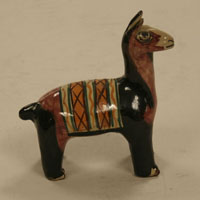
Llama
Unknown Maker
Peru
Llama, 20th century
Ceramic, 5 7/8 x 2 3/8 inches
Gift of Dr. & Mrs. Russell J. Seibert
This ceramic depicting a llama could have been purchased in any number of trading markets throughout Peru. The patterning on the back of this llama recalls the hand-woven and decorated woolen textiles used throughout the Andes as blankets and saddlebags for these beasts of burden.
More about this item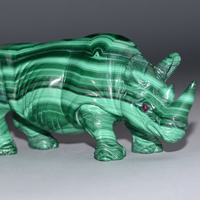
Rhinoceros
Unknown Carver
Rhinoceros, 20th century
Malachite, 3 x 6 x 2 1/4 inches
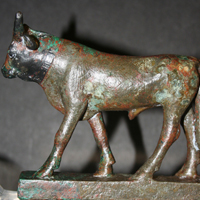
Apis Bull
Unknown Artist
Egypt
Apis Bull, 600-300 BCE
Leaded bronze, polychrome, 4 3/4 x 5 x 1 1/2 inches
Gift of Mr. Alan Gerdau
Apis is the divine bull of the ancient Egyptian capital Memphis, and it is a manifestation of the god Ptah, a creator and maker of all things. The original name in Egyptian was Api, Hapi, or Hep. Apis is the Greek name, meaning courageous heart, great strength, and fighting spirit. It symbolizes strength and fertility, qualities closely linked with kingship. Occasionally, Apis appears with the sun-disk symbol of his mother, Hathor, between his horns. Apis is one of very few deities associated with her symbol, signifying goodness and plenty. The cult of Apis celebrated the bull, which represented harmony in nature and a balanced universe.
More about this item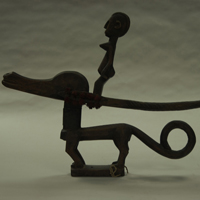
Chi Wara and Figure
Unknown Bamana/Bambara Carver
Mali, Africa
Chi Wara and Figure, 20th century
Wood, fiber, metal, 28 x 18 x 5 1/2 inches
Gift of Geneva R. Steinberger
The Chi Wara represents the roan antelope, an intercessor that sustains human and natural fertility. The female antelope is usually depicted in a horizontal stance and carries a young antelope on her back, symbolizing human beings protected by the heroic Chi Wara. In this case, the antelope is instead carrying a female figure in a literal interpretation of this belief. At festivals, the Chi Wara figures always appear as a male/female pair, combining the elements of fertility of humans with fertility of the earth. The carvings are placed on the heads of dancers fully clad in raffia. Their movements replicate the antelope reinvigorating the soil, thus assuring a bountiful harvest. Of the differing regional styles, this carving likely comes from the north region of Mali called Bamako.
More about this item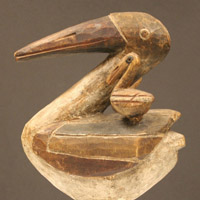
a-Bamp/e-Bemp Headdress
Unknown Baga Carver
Guinea, Africa
a-Bamp/e-Bemp Headdress, mid-20th century
Wood, polychrome, 16 1/8 x 5 3/4 x 10 inches
Gift of Mr. & Mrs. Martin Goodman
Often depicted as an aquatic bird, an a-Bamp or e-Bamp literally translates as “the bird.” In this object, the bird is a hornbill, although in other examples herons or pelicans can appear. It carries two smaller hornbills on its back. In some instances, the object is worn on the forehead while hunting. Hunters mimic the up and down movements of the birds, blending into the flock unnoticed. Also, young men and boys wear this form of headdress during initiation into the Baga harvest festival ceremony, where, like the hunters, they perform these same movements jumping from left to right and nodding their heads as though they are socializing among the flock.
More about this item![Elephant [Alice]](https://exhibitions.lib.udel.edu/collectors-cabinet/wp-content/uploads/sites/234/2021/02/016_thumb.jpg )
Elephant [Alice]
Anna Vaughan Hyatt Huntington (United States, 1876-1973)
Elephant [Alice], executed by Gorham ca. 1920
Bronze, 13 7/8 x 11 1/4 inches
Gift of the Gorham Corporation
Historically, many elephants, both of the African and Asian species, have been named Alice.
The Alice who was likely the model for Anna Huntington’s sculpture was an Asian elephant owned in 1905 by Frank Thompson at Luna Park, Coney Island, NY. Making a dramatic escape, Alice took to the water, swam north out of Luna Park, and slipped into the Coney Island Creek. From there, she swam west, undetected, passing the Coney Island Lighthouse and continuing another five miles—across one of the busiest ports in the world—where fishermen spotted her off the Staten Island coast just before dawn. In 1908, Alice went to the Bronx Zoo, where Huntington studied and sculpted Alice among other animals.
More about this item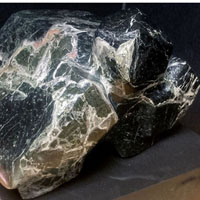
Turtle
Richard H. Bailey (United States, b. 1940)
Turtle, 1969
Serpentine, 15 1/2 x 18 x 9 7/8 inches
Purchase Award 9th Annual Regional Art Exhibition, 1970
Delaware sculptor, Richard H. Bailey has been carving stone for over sixty years and is known as “The Marble Man.” Bailey’s handcrafted sculptures are carved primarily from marble, but also granite and precious stones, which he selects. His subjects include twisting fish, butterflies, ducks, and monumental turtles expressing his deeply rooted interest in nature and faith. This sculpture appears to be a sea turtle with prominent front flippers. Bailey studied at the Art Students League in New York City with José de Creeft and at de Creeft’s home studio in Hoosick Falls, New York for two summers, before attending the Carlo Nicoli Studios in Italy, where he studied with ten stone sculptors. Returning to New York City, Bailey studied at the New School of Social Research. Continuing his extensive training, he took drawing classes at Goddard College in Plainfield, Vermont and learned many techniques for carving granite in Barre, Vermont.
More about this itemTextiles
From fig leaves to animal pelts, textiles have evolved to warm, enhance, and adorn the human form. The weaver’s craft shown in this cabinet also extends to other fibers used in decorative and functional ways.
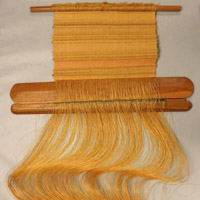
Loom
Unknown Quechua Maker
Peru
Loom, 20th century
Wood, fiber, 23 1/4 x 17 3/4 inches
Gift of Dr. & Mrs. Russell J. Seibert
In the Andes, traditional Quechua weaving uses the backstrap loom, the oldest form of loom in the world. An entirely non-mechanized instrument, it is constructed using wood, bone, and strings. It is easily portable from home to field, wrapped inside the lliqlla or manta (carrying shawl) that every woman traditionally wears.
More about this item![Hat [Montera]](https://exhibitions.lib.udel.edu/collectors-cabinet/wp-content/uploads/sites/234/2021/02/029_thumb.jpg )
Hat [Montera]
Unknown Quechua Artist
Cuzco/Cusco, Peru
Hat [Montera], early 20th century
Wool, appliqué, 15 3/4 inches diameter
Gift of Dr. and Mrs. Russell J. Seibert
Montera is a Quechua word for a traditional hat, which varies in style depending upon the region. This hat sits squarely on the top of the head and would traditionally be secured under the chin with ties of white beads. In more contemporary examples such as this one, commercially produced trims or braiding are used. The base fiber used in this Montera is dyed alpaca wool. This hat is from the city of Cuzco (now Cusco). It was the historic capital of the Inca Empire from the 13th century until the 16th-century Spanish conquest.
More about this item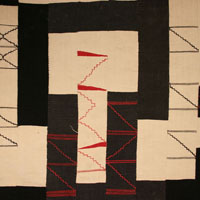
Strip Cloth Textile
Unknown Vai Artist
Liberia, Africa
Strip Cloth Textile, 20th century
Cotton, 120 x 41 inches
Gift of Mrs. Rose Joseph
This is an example of Liberian strip weaving. The weaver joined the strips to create abstract patterns. The dyes used were likely kaolin clay for the white, charcoal or black clay, and red from Camwood or madder. Inconsistencies, in the black strips in particular, reflect the differences in how the cloth accepts the dye, or how long the fibers might have been in the dyeing pit. In the red areas, both woven and embroidered threads are seen in the pattern.
More about this item
Child’s Manta
Unknown Huancayo Maker
Peru
Child’s Manta, 1970s
Wool, embroidery; 20 1/4 inches x 14 1/4 inches
Gift of Dr. & Mrs. Russell J. Seibert
A manta originally was worn only during ceremonial events in the Huancayo Highlands of Peru. Now the term covers all poncho-like garments. This manta is unusual, as it was made for a child. The distinctive embroidery for such mantas traditionally was sewn by men. In this case, it is quite minimal compared to others of the same era, in which the entire surface is covered with multicolored floral and foliate designs.
More about this item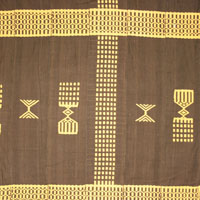
Strip Cloth Textile
Unknown Vai Artist
Liberia, Africa
Strip Cloth Textile, 20th century
Cotton, 74 x 48 inches
Gift of Mrs. Rose Joseph
Traditionally, Liberian country cloth is handspun, hand-dyed, and hand-woven cotton. It is usually woven in about four-inch-wide strips, which are then sewn together. A bolt of the fabric normally measures thirty-six yards long. In this textile, the cloth is dyed dark brown, with yellow accents depicting spools and heddle pulleys used in the weaving and manufacturing process of the cloth. Both decorative and narrative, this example speaks of the weaver’s craft. Natural dyes like kola nuts for the brown and dyes from the Morinda brimstone tree would have been used for the golden yellow, although saffron dye was sometimes substituted.
More about this item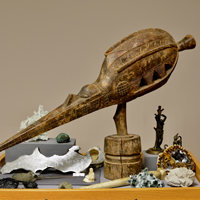
Evolving Identities
The form and function of an object may change due to reinterpretation or research, or to actual transformation. This may result in a change in nomenclature. For instance, mineral pseudomorphs are specimens manifesting a change in form. Discoveries through research, provenance, and updated attributions can provide examples of a change in the understanding of an object’s function. One of the most rewarding activities in studying collections of all kinds is uncovering new evidence in identifying the true nature of a specimen or object.

Tektites
Tektites
Indo-China
2 x 1 1/2 inches (of the largest tektite)
Gift of Alvin B. Stiles
Tektites were thought to be of extraterrestrial origin until very recently. University of Delaware professor Dr. Billy Glass was instrumental in the discovery that tektites are, in fact, glass formed by the melting and rapid cooling of terrestrial rocks, which were vaporized by the impact of meteorites, comets, or asteroids on the earth’s surface.
More about this item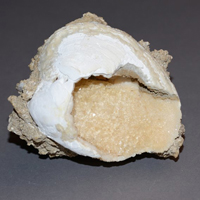
Calcite in shell
Calcite in shell
Virginia Beach, Virginia
3 x 3 1/2 x 3 inches
The “dogtooth” (or scalenohedral) calcite crystals grew inside the fossil mercenaria clam shell, long after the formation of the fossil. These are found in areas from Virginia to Florida, known to have once been beach edges.
More about this item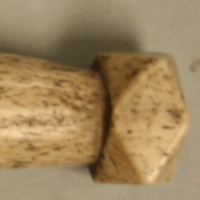
Fisherman’s Fid
Unknown Maker
Country Unknown
Fisherman’s Fid, 18th-19th century
Whalebone, 15 5/8 x 1 3/8 inches
Gift of Mr. Alan Gerdau
This object was presented to the collection as a Maori War Club. In doing provenance research, this object bore no similarity to a Maori club, scepter, or any other indigenous device. However, it is likely that this was found in the South Seas and was probably purchased in New Zealand. In fact, this object is called a fisherman’s fid, a hook used to repair rope nets. These fids were typically made of whalebone, a by-product of the commercial whaling industry. These were seldom seen after the mid-19th century, due to whaling restrictions and changes in the nets used.
More about this item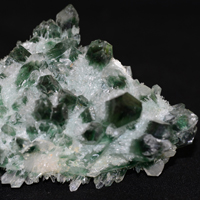
Quartz
Quartz
China
2 ½ x 4 ½ x 1 ½ inches
Gift of Michael C. Hughes and Anneve Yarr
The specimen of quartz was originally a natural white or transparent crystal group. It has been dyed green, and small, brilliant, clear quartz crystals have been synthetically grown onto the original quartz. These specimens are currently produced in China and the sophisticated technology to produce such crystals involves very high heat and pressure. These specimens are beautiful, but unfortunately, they are mostly sold and represented as completely natural.
More about this item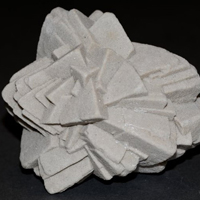
Calcite enclosing sand
Calcite enclosing sand
Seine-et-Marne, Fontainebleau, France
3 x 4 x 2 1/2 inches
Gift of Philip G. Rust
As the calcite crystals grew, they incorporated sand into their structure, sometimes containing up to fifty percent sand. Sand-included calcite is rare, occurring at this locality in France and at Rattlesnake Butte in South Dakota. Found in a cave in the forest, which was being mined for sandstone, these strange groups of crystals were described and shown in an auction catalog in 1778. The mine later closed and was forgotten. Rediscovered in 1850, it attracted mineral collectors until 1891, when the town filled the cave with sand and fenced it in. Steel bars now protect “Grotte aux Cristaux” but visitors can see some cave walls covered with the sand calcite crystals. The famous mirrors of Versailles and the glass of the I. M. Pei pyramid of the Louvre were made from the quartz sands from the Fontainebleau quarries.
More about this item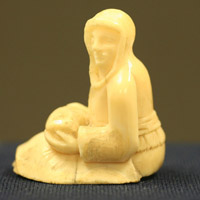
Mother and Child
Unknown Yup’ik Artist
Alaska or Northwest North America
Mother and Child, early to mid-20th century
2 x 1 1/4 x 1 5/8 inches
Gift of Dr. & Mrs. Willi Riese
This small figure, variously identified in the collection over the years as an amulet, piece of jewelry, or talisman, has remained a mystery. Adding to the intrigue were two rounded protruding pieces on the bottom, indicating it is a part of a larger whole. It was not until 2001, with the subsequent gift of several Yup’ik baskets from Mabel and Harley McKeague, that the mystery was solved; the figure is a toggle, or knob, that fits on the lid of a basket, a common decorative element.
More about this item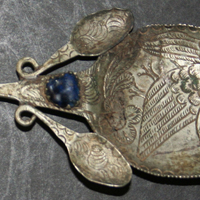
Tupu/Topo
Unknown Artist
Huancayo, Andes, Peru
Tupu/Topo, 19th-20th century
Nickel/silver alloy, blue stone, 8 7/8 x 2 1/4 inches
Gift of Dr. & Mrs. Russell J. Seibert
This object is a tupu or Topo, a Quechua term for pin. It is made of repoussé silver with high nickel content, probably manufactured from coins. Women in the Andes use these pins to fasten their garments. They typically wear two tupus, their heads pointed downward, to fasten the acsu or anacu, a rectangular textile (dress) made of camelid wool (alpaca or vicuña) that wraps around the body. The donor had identified the object as a Topo. However, in intake cataloguing by another department, a descriptive title of “Ritual Spoon” was adopted. The records were revised when the original inventory lists came to the museum in the 1990s.
More about this item
Pyritized brachiopod
Pyritized brachiopod
Sylvania, Ohio
2 x 2 x 1 inches
Over time, the mineral pyrite has, atom by atom, completely replaced the calcium carbonate shell of this ancient brachiopod. Brachiopods, similar to mollusks, were abundant in the early history of the earth, although few species remain today.
More about this item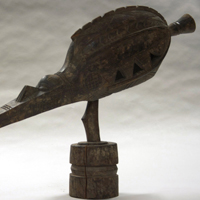
Anok/Elek
Unknown Baga Carver
Guinea, Africa
Anok/Elek, 19th-early 20th century
Wood, 34 3/8 x 3 5/8 x 20 1/2 inches (including base)
Gift of William C. Lickle
Anok sculptures, also called Elek, are bird-shaped heads with human features. These sculptures were used during the harvest to protect the communities’ food from evil spirits. They are also used during funeral processions, protecting spirits and ushering the ancestors safely into the afterlife. The Anok is kept as an important shrine found in many Baga households. Upon entering the collection separately, the base was identified as a Yoruba scepter, and the avian head was properly named as an Anok. Research has corrected the Yoruban attribution, and the two pieces are now appropriately joined.
More about this item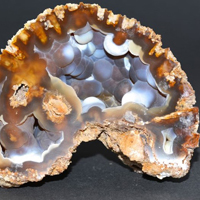
Agatized coral
Agatized coral
Tampa Bay, Hillsborough County, Florida
4 x 5 x 2 inches
This specimen of agatized coral began as a live coral colony composed of calcium carbonate. After it died the coral was replaced by microscopic quartz, called chalcedony, in a process that is estimated to have taken 20 to 30 million years. There are several localities where agatized coral is found in Florida and it has been named the Florida state rock.
More about this item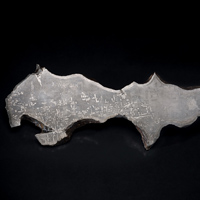
Iron (Youndegin) Meteorite (octahedrite)
Iron (Youndegin) Meteorite (octahedrite)
Found in Youndegin, Australia
4 x 13 x 1/2 inches
Estate of Irénée du Pont
Not until the early 1800s was the extraterrestrial origin of meteorites determined; before that, they were thought to be scrap metal or iron minerals. This cut and polished slice of a larger three-ton meteorite was purchased by Irénée du Pont from Ward’s Natural Science Establishment in 1924. The first portion of this meteorite fall was discovered in an unpopulated area in Australia, January 5, 1884, and named for a nearby police station. Portions were sent to England as scrap metal but were identified as meteorites by scientists at the British Museum, where they reside today. The intricate pattern shown on the surface is called “Widmanstatten” structure and is formed by the interweaving of nickel-rich and nickel-poor iron zones in some types of meteorites.
More about this item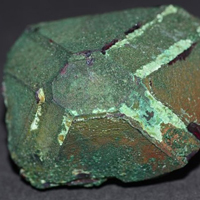
Cuprite
Cuprite
Onganja Mine, Windhoek District, Khomas Region, Namibia
1 1/2 x 2 x 1 1/4 inches
The specimen appears to be a large single crystal of malachite. However, malachite crystals of this size are unknown, and the crystal form is not possible in malachite. This is a single octahedral crystal of the mineral cuprite with a thin coating of malachite. Although Onganja is the site of early copper mining dating back to the 17th century, large-scale mining began only in 1960. In 1973 the largest cuprite crystals ever discovered were found underground, all partially or completely coated in malachite. The discovery of these amazing crystals contributed to the demise of the mine as the miners searched for these valuable specimens instead of mining for copper.
More about this item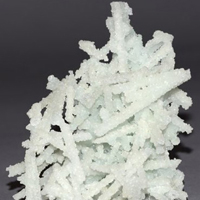
Prehnite after Laumontite
Prehnite after Laumontite
Mumbai, District, Maharashtra, India
4 x 5 1/2 x 3 1/2 inches
This specimen of prehnite is a pseudomorph, or “false form,” as the original mineral was laumontite, which was later coated by prehnite. The original white laumontite then completely dissolved, leaving the outer hollow framework of pale green prehnite.
More about this item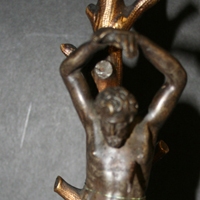
Saint Sebastian, 19th century (tree)
Unknown Artist(s)
Padua, Italy (tree); possibly Germany (figure)
Saint Sebastian, 19th century (tree); 15th-17th century (figure)
Bronze, 5 1/2 x 2 x 1 1/2 inches
Gift of Mr. Alan Gerdau
This enigmatic sculpture of Saint Sebastian against a tree has puzzled university researchers over the years. It was quickly noted that the tree was made in Italy, and the donor likely purchased this ensemble in Padua. The figure, posed with the arms extended above the head, has a looser and slightly more blocky form than is common in Italian bronzes and paintings of the subject. It bears more of a resemblance to German depictions of Saint Sebastian.
More about this item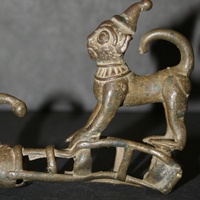
Monkey Palad Khik
Unknown Artist
Thailand
Monkey Palad Khik, late 19th-early 20th century
Brass, 4 1/8 x 7/8 x 3 inches
Gift of Mr. & Mrs. Samuel Eilenberg
This object was formerly identified as an “Animal on a Sled.” Subsequent research indicates it is likely an amulet widely worn by both men and women in Thailand, called a Palad Khik. The Palad Khik, a phallic representation of the deity Shiva, is also an animistic symbol of fertility, often protected by the sacred monkey. In this object, the monkey is similar in style to the golden crowned monkeys at the royal palace in Thailand. Thais place a great deal of importance on such talismans, wearing them at the waist beneath their clothing, assuring the wearer of power and increased fecundity.
More about this item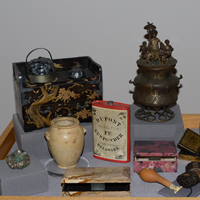
Containers and Boxes
Everyone needs containers, and several objects in this cabinet serve that function very well. There are, however, things fitting the title’s description that do not or are not meant for storage at all.

Beryl (emerald) bowl
Beryl (emerald) bowl
Takovvaya River emerald deposit, Urals, Russia
1 3/4 x 2 inches
Estate of Irénée du Pont
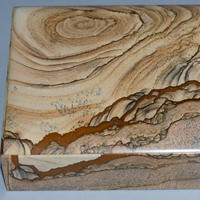
Picture Jasper box
Picture Jasper box
Material from Biggs, Oregon
4 x 6 x 1 1/4 inches
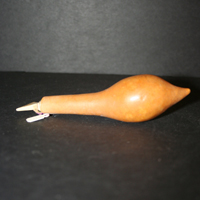
Coca Gourd
Unknown Maker
Quechua Highlands, Peru
Coca Gourd, early 20th century
Gourd, bone, 5 1/4 inches long
Gift of Dr. & Mrs. Russell J. Seibert
Chewing coca leaves is common in indigenous communities across the central Andean region like the highlands of Argentina, Colombia, Bolivia, and Peru. There the cultivation and consumption of coca is a part of each nation’s culture and is an important part of traditions such as funerals. This gourd has traces of the alkaline powdered substance called lime (not to be confused with the green fruit) still visible inside. The powder is created by burning and refining quinoa leaves, and is added to the coca to soften its astringent qualities. Placing the powder inside the “chew” creates a chemical barrier so the corrosive coca does not come directly in contact with the gums and cheek.
More about this item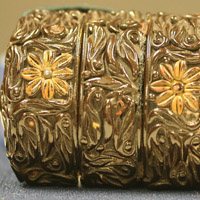
Three Case Inro
Unknown Artist
Japan
Three Case Inro, late 19th or early 20th century
Lacquered wood, 4 x 2 7/8 inches
Gift of William M. Donaldson
This Japanese inro was used to store medicine tablets inside three chambers. Each section has a small oval receptacle. Silk cord is woven through holes on each side of the box allowing each section to be slid open, then retightened to keep the box firmly closed. This inro would be suspended on a decorative netsuke attached to the obi (sash) of the kimono. The inro was, and is, one of the most popular forms of personal lacquerware.
More about this item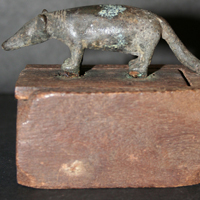
Ichneumon and Sarcophagus
Unknown Artist
Egypt
Ichneumon and Sarcophagus, 600-300 BCE
Bronze, wood
4 1/8 x 1 1/2 x 1/2 inches (ichneumon); 2 x 3 3/8 x 5 1/4 inches (box)
Gift of Julius Carlebach
An ichneumon is an Egyptian mongoose, which is considered a protector of the blind and a defender against deadly snakes and evil forces. The animal is attached into holes in the lid with protrusions, called tangs, beneath its feet. The sloping tail prevents the lid from being slid open, securing the mummified relic of the ichneumon, which is no longer inside.
More about this item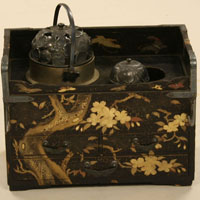
Shibayama Smoker’s Companion Tobacco Box
Unknown Artist
Japan
Shibayama Smoker’s Companion Tobacco Box, likely Meiji Period, 1868-1912
Lacquered wood, silver, gold and natural inlays, 8 1/2 x 6 inches
Donor Unknown
The lacquer inlay art form known as Shibayama is named after an area in Japan within the present-day Chiba prefecture. Created by Ōnoki Senzō, an Edo haberdasher who lived during the An’ei era (1772-1781), Shibayama inlay is unique in that it is raised in relief on the surface instead of being flush with it. From the 8th century onward, Japanese artisans perfected the practice of sprinkling gold and other pigment-producing materials into the wet lacquer, a technique known as maki-e. Sometimes gold was polished until it glowed, and other times it appeared in relief to give lacquerware dimension. These characteristics are demonstrated to their fullest on this tobacco box. The silver butterfly drawer pulls, resting hooks for the pipe, tobacco humidor, and brazier lid are intact on this box. The only missing portions are the silver carrying handle and the interior cup of the brazier.
More about this item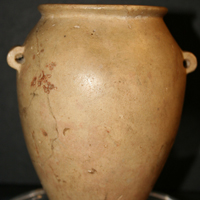
Shoulder Handled Jar
Unknown Artist
Pre-dynastic Egypt
Shoulder Handled Jar, 3600-3200 BCE
Alabaster, 4 7/8 inches high x 2 7/8 inches diameter (of opening)
Gift of Mr. Leonard Epstein
Ubiquitous in early Egypt, these jars held mixtures used in the preparation and embalming of mummies. They were also used to store ointments or perfumes used in everyday life. Jars were formed from the stone using flint tools to roughly shape the vase, then polished with a harder stone, and finally smoothed using emery or carborundum sands. Interiors of such jars were hollowed out using drills. The drills were usually made of hollow tubular copper attached to a wooden shaft or a stone drill bit, which were rotated vertically between the palms of the hands. The drills have not survived, but parts of vase-making tool kits have been found at tomb sites.
More about this item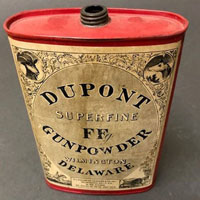
DUPONT gunpowder tin
DUPONT gunpowder tin
4 x 6 inches
Gift of Janet Hartford
As described on its decorative label, the empty tin held one pound of superfine gunpowder for the re-loading of bullets for rifles during the 1920s. E.I. du Pont de Nemours and Company was founded by Éleuthère Irénée du Pont (1771-1834) in 1802 to manufacture gunpowder. Du Pont, originally from France, was the student of the renowned chemist Antoine Lavoisier (1743-1794). The company built factories along the Brandywine River in Wilmington, Delaware and transported materials on the Delaware River. The manufacturing process was dangerous and there were numerous explosions over the years, but blasting in mines and the construction of roads and railroads increased the demand for gunpowder.
More about this item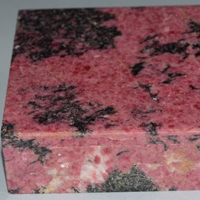
Rhodonite box
Rhodonite box
Material from Russia
4 1/4 x 4 1/4 x 1 1/2 inches
This finely made hinged box of vivid dark pink rhodonite with black manganese oxide minerals is lined with white marble.
More about this item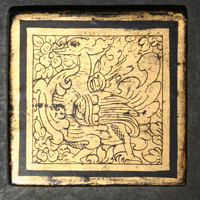
Lidded box
Unknown Artist
Thailand, or possibly Myanmar
Lidded box, ca. 1930 or earlier
Lacquered wood, gold leaf, 4 7/8 inches long x 2 1/4 inches deep
Gift of Dr. & Mrs. Willi Riese
Trinket boxes such as these were, and are, widely used throughout Thailand and Myanmar. This two-part box is like the Japanese inro (similar to the object in the Jewels, Adornments and Keepsakes cabinet ) in that it held medicines, coins, and other small objects. The difference is that boxes such as these would not dangle from a netsuke, but rather, be tucked into a sash, carried in a mesh bag, or slid inside a sleeve.
More about this item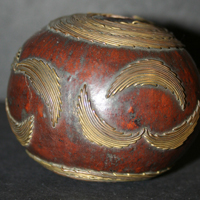
Calabash Cup/Vase
Unknown Maker
Madagascar
Calabash Cup/Vase, early 20th century
Gourd, brass wire, 1 7/8 inches high
Donor Unknown
This cup was created from a calabash gourd, not to be confused with the large hollow fruits, which grow on trees. Calabash gourds originated in southern Africa and Madagascar and have many uses. In this example, the gourd is enhanced using simple wire decoration, which is both pleasing to the eye and provides a good gripping surface.
More about this item
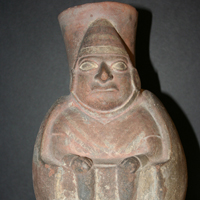
Seated Priest Effigy Spout Jar
Unknown Maker
Moche III, Peru
Seated Priest Effigy Spout Jar, 450-550 CE
Ceramic, Redware, 8 1/2 inches high
Bequest of Miss Jane Maxwell, given in memory of her father, James Maxwell
The utility of this vessel is not fully understood. Moche vessels could have had various everyday uses, as well as serving as funerary objects. This example depicts a warrior-priest in a typical seated position with his hands resting on his lap.
Moche ceramics are normally mold made and are manifested in a narrow range of styles: stirrup spout vessels, bottles, portrait heads, and flaring spout jars. Moche society flourished on the north Peruvian coastal desert between the 1st and the 8th centuries CE, in valleys irrigated by rivers flowing westward from the Andes to the Pacific Ocean.
More about this item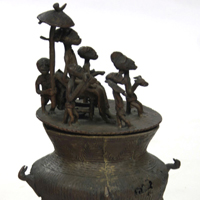
Kuduo
Unknown Asante Artist
Ghana, Africa
Kuduo, 20th century
Cast Alloy, Copper, Brass
Gift of Geneva R. Steinberger
Kings and persons of influence in the Akan culture own brass vessels called kuduo. These receptacles are meant to hold gold dust (a medium of monetary exchange) or other valuables. The kuduo serves the symbolic purpose of safeguarding their owners’ kra, or life force. Kuduo plays an important role in ceremonies intended to maintain the spiritual well-being of those who own them.
More about this item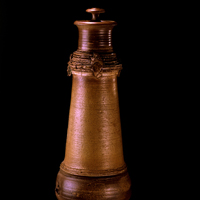
Lidded Vessel
Victor Spinski (United States, 1940-2013)
Lidded Vessel, ca. 1968
Porcelain, 40 1/2 inches high
Purchase Award, 7th Regional Art Exhibition, 1968
Victor Spinski is best known for his ceramic trompe l’oeil still lifes of everyday objects such as polystyrene foam coffee cups or plastic spoons in garbage cans. His inspiration came from the Yixing artists of eastern China, as reflected in this monumental, lidded porcelain vessel.
Spinski was Professor of Ceramics at the University of Delaware from 1968-2006. This vessel is an example of his early work done at the university. Despite the traditional appearance, it was made during the period when Spinski was considered a leader in the avant-garde ceramics movement of the 1960s and 1970s. He held a patent on a ceramics photo emulsion process, which allowed him to produce decals. This further enhanced his later trompe l’oeil ceramic designs, such as printed cardboard boxes or portraiture.
More about this item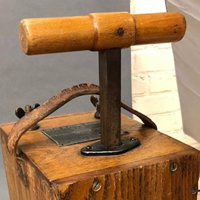
Atlas Blasting Machine
Atlas Powder Company
Atlas Blasting Machine, after 1912
8 x 17 x 6 1/2 inches
Gift of Janet Hartford
Blasting machines, invented by Henry Julius Smith of Mountain View, New Jersey, fired a blasting cap to detonate dynamite for use in mining and construction. The machine shown is from the Atlas Powder Company, Wilmington, Delaware and was made sometime after Atlas was split off from the E. I. DuPont Powder Company in 1912. The metal plaque reads:
No. 3-50, Atlas Powder Company, Wilmington, Delaware
Explosives, Capacity, 50-30 feet copper wire, Electric Blasting Caps.
More about this item
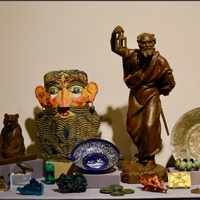
Copper
Copper (Cu) was known in ancient civilizations and was smelted with zinc to make brass and with tin to make bronze. Copper is an element that occurs naturally as crystalline copper. It also combines with other elements, making up other minerals, some of which are very colorful.
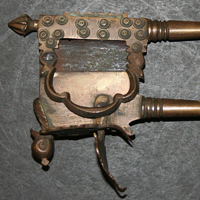
Betel Nut Cutting Utensil
Unknown Maker
Betel Nut Cutting Utensil
India, ca. 1930 or earlier
Brass, 6 3/4 x 2 3/8 inches
Donor Unknown
Betel nut is the seed of the fruit of the areca palm, and is also known as areca nut. Betel nut chewing is ubiquitous throughout southeastern Asia, but is most widespread in India. The nuts are prepared by slicing the areca berries, and when the “chew” is combined with betel leaves it is referred to as paan. The chewing has similar effects as tobacco or caffeine, and like chewing tobacco, has carcinogenic effects on the mouth, gums, and esophagus. Although the source of this utensil is unknown, it is similar in style to other antique cutters from the 1930s or earlier.
More about this item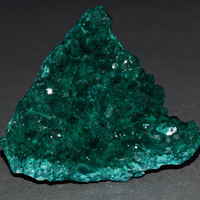
Dioptase
Dioptase
Renéville Mine, Kindanba District, Republic of the Congo
3 1/4 x 3 3/4 x 1 inches
Dioptase was found at the Renéville Mine, before the mineral was found in greater abundance in Tsumeb, Namibia. A dark, bright green mineral, it is difficult to reproduce its true color in a photograph.
More about this item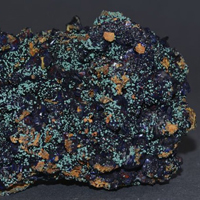
Azurite and Malachite
Azurite and Malachite
Bisbee, Warren District, Cochise County, Arizona
3 x 4 1/2 x 2 inches
Gift of Alvin B. Stiles
The azurite (deep blue) and malachite (green) specimen was found in the early days of mining in Bisbee and each is colored by the element copper. Specimens have been prized since the 1880s, before most of the vast copper deposits there were discovered. Miners and managers of the mines preserved specimens and built great collections, many of which are today in major museums. Although the most widely known minerals are azurite and malachite, more than 300 species have been discovered in the mines.
More about this item
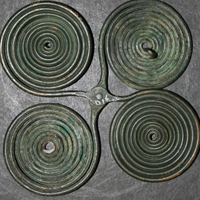
Double Spectacle Fibula
Unknown Greek Artist
Sparta Region, Greece
Double Spectacle Fibula, 9th-8th century BCE
Bronze, 5 x 5 inches
Gift of Mr. and Mrs. Samuel Eilenberg
A fibula is an ancient clasp used to secure clothing. The spirals are referred to as spectacles. There are four classifications of these fibulae, and this one is a Type IV, which is constructed in a one-piece manner. This differs from later examples of this type where the spectacles were attached separately to the pin mount. Multiple piece fibulae were found in the Greek Islands and Sicily. This one-piece variety was typical of an earlier time and was widely found in Sparta.
More about this item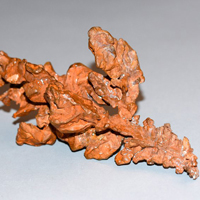
Copper
Copper
Houghton County, Keweenaw Peninsula, Michigan
2 1/2 x 6 1/2 x 3 inches
The spear-shaped specimen of the element copper is a twin crystal—two intergrown crystals. The possible crystalline shapes of copper are numerous, occurring in branching tree-like patterns or as cubes, dodecahedrons, or octahedrons. Thousands of Michigan copper specimens have been preserved in collections all over the world.
More about this item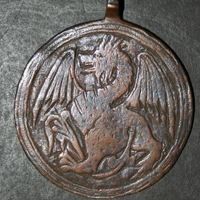
Chimera Medallion/Amulet
Unknown Artist
Italy
Chimera Medallion/Amulet, 15th-17th century
Bronze, 2 7/8 x 2 3/8 inches diameter
Donor Unknown
There is sometimes confusion about the difference between a Chimera and Gryphon (Griffon). A gryphon is a combination of lion and eagle, while a chimera is a composite of many animals. This medallion is likely a chimera as it has the body of a lion, wings of an eagle, and the head and neck of a serpent or dragon.
More about this item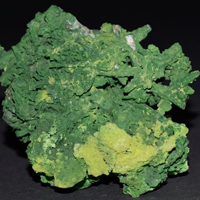
Bayldonite
Bayldonite
Tsumeb Mine, Tsumeb, Oshikito Region, Namibia
3 1/2 x 4 x 1 1/2 inches
Estate of Frederick A. Keidel
The bayldonite specimen is from early mining days in Tsumeb in the late 1800s and is from near surface parts of the deposit. The specimen was originally the mineral mimetite but over time was replaced by the mineral bayldonite. This transformation is called “pseudomorphism,” as the crystal shape is still that of mimetite, but the chemical composition is now the copper mineral bayldonite.
More about this item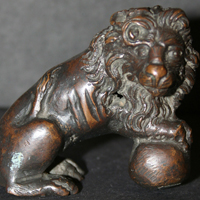
Miniature of a Medici Lion
Unknown Artist
Italy
Miniature of a Medici Lion, 17th century
Bronze, 2 1/8 x 1 7/8 x 1 1/2 inches
Gift of Mr. Alan Gerdau
This bronze sculpture is modeled after a Medici lion. The Medici lions are a pair of marble sculptures. One is Roman, dating to the 2nd century CE, and the other is a 16th century companion piece. In 1598 the lions were placed at the Villa Medici in Rome. Since 1789 they have been displayed at the Loggia dei Lanzi in Florence. The sculptures depict standing male lions with a sphere or ball under one paw, looking to the side. This miniature is one of many copies of the Medici lions that appear throughout Europe.
More about this item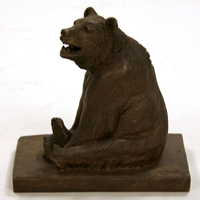
Bear
J. Harrison Wright (United States, dates unknown)
Bear, 1927
Bronze, 8 x 4 7/8 inches
Gift of the Gorham Corporation
Like other sculptures in this exhibition, this bear is another example of a small animal figure cast at the Gorham Foundry.
More about this item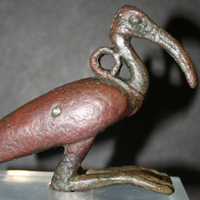
Thoth Ibis Effigy
Unknown Artist
Egypt
Thoth Ibis Effigy, 600-300 BCE
Leaded bronze, polychrome traces, 4 x 3 3/4 inches
Gift of Mr. Alan Gerdau
In ancient Egyptian culture the ibis was an incarnation of Thoth, who represents the moon, wisdom, speech, writing, science, and magic. An ibis’s main function was to serve as the counselor and healer to Horus, the son of Osiris. X-ray fluorescence analysis was performed on this ibis, and it was discovered that the bronze body is composed of 81% copper, 16% lead, and 1% zinc. The feet (a later addition) are a brass alloy of 82% copper, 11% zinc, 3% antimony, 2% lead, and 1% tin.
More about this item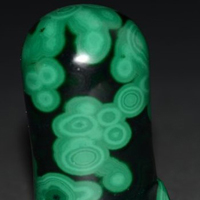
Malachite
Malachite
Katanga Copper Crescent, Democratic Republic of Congo
1 1/2 x 3 1/2 x 1 1/2 inches
The stalactite of malachite has been polished in such a way that it does not display rough natural surfaces but shows the “eyes” in malachite.
More about this item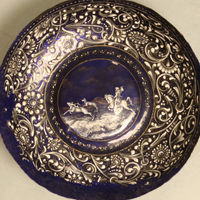
Limoges Bowl
Unknown Artist
France
Limoges Bowl, 17th century
Copper, enamel, 1 7/8 x 7 1/2 inches diameter
Gift of Mr. Alan Gerdau
This bowl is made of pure raised copper. It originated at Limoges, a region in southwestern France, noted for enamelware, porcelain, and fine china. The decoration is painted using enamels ground to a fine powder and mixed with a very small amount of binder, such as gum arabic. After painting, the vessel is fired at approximately 1100 to 1550 degrees Fahrenheit, which burns away the binder and fuses the enamel to the copper bowl. The bowl has been consolidated and inpainted in areas of enamel loss along the lower edge. Nevertheless, the large areas of the decorative sides and the whole of the central stag hunt scene in grisaille technique are intact.
More about this item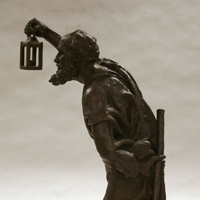
Diogenes
George Edwin Bissell, Sr. (United States, 1839-1920)
Diogenes, 1906
Bronze, 24 3/8 x 14 3/8 inches
Gift of the Gorham Corporation
George Edwin Bissell’s best-known sculptural works are figural monuments commemorating Civil War leaders or other dignitaries. The Gorham Foundry cast this figure of Diogenes in 1906. Diogenes was a Greek philosopher known for holding a lantern and claiming to be on a quest for an honest man. Diogenes is considered to be one of the founders of Cynicism – a doctrine that supports a life in accordance with nature and rejects convention. It is unknown whether this figure was cast in any other size beyond the small form seen in this bronze.
More about this item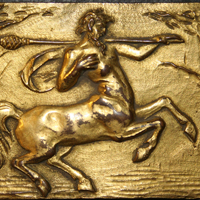
Plaque, Centaur
Unknown Artist
Padua, Italy
Plaque, Centaur, 17th-19th century
Bronze, gilding, 2 1/4 x 3 3/8 inches
Gift of Mr. Alan Gerdau
In Greek mythology, the centaur was half-man and half-horse. These creatures represented barbarism and unbridled chaos and were frequently represented in Greek architectural sculpture and pottery decoration. The usage of this small plaque is unclear, but similar ones appeared as book cover inlays, commemorative medals, and architectural decoration.
More about this item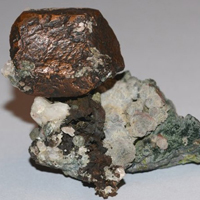
Copper
Copper
Adventure Mine, Greenland, Ontonagon County, Michigan
2 x 3 x 2 inches
The specimen of copper is a single crystal that is perched on a matrix. The Adventure Mine operated from 1850 to 1917 for the mining of copper and was reopened for underground tours in the 1970s.
More about this item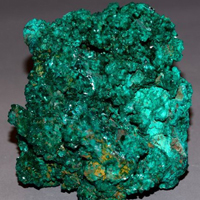
Dioptase
Dioptase
Reneville Mine, Kindanba District, Republic of the Congo
5 x 6 x 4 1/2 inches
Gift of David A. Byers
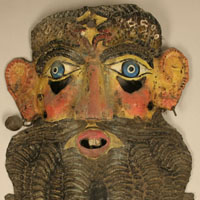
Carnival Mask
Unknown Artist
Altamirano, Guerrero Mexico
Carnival Mask, ca. 1900
Copper, polychrome, fabric, 14 1/2 x 12 1/2 inches
Gift of Geneva R. Steinberger
The use of masks and costumes was an important part of Mesoamerican cultures long before the arrival of the Spanish. This particular mask is made out of sheet copper, and was used during Carnival. Although many Carnival masks are made of leather and molded to the wearer’s face, this mask has been reverse hammered in a process called repoussé. In areas where it contacts the face, remnants of cloth have been adhered to shield the skin against heat buildup and oxidation of the copper.
More about this item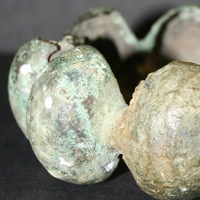
Anklet
Unknown Artist
Celtic Northern Europe
Anklet, 250-225 BCE
Bronze, 3 1/2 x 1 3/4 inches
Gift of Mr. and Mrs. Arnold Saltzman
Celts probably originated in southwestern Germany and eastern France, but then quickly migrated throughout northern Europe. This explains, in part, why anklets like these are found in so many locations. The round shape of this piece of jewelry indicates it was worn on the ankle, and not on the upper arm, where an oval bracelet would have provided a more appropriate design and a more snug fit. Although the metal is thin, it is also too large and weighty to wear on a wrist.
More about this item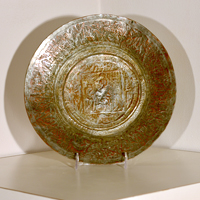
Engraved Plate
Unknown Artist
Syria
Engraved Plate, 17th-20th century
Silver gilded copper, 12 inches diameter x 1 1/2 inches high
Gift of Julius Carlebach
Along the edge of this engraved plate is a frieze of incised human figures and animals. The design at the center of the plate shows a man seated on a camel inside an incised square. The images are partly engraved and partially created using punchwork. The wear on the silver gilt is extensive and clearly shows the copper of the plate.
More about this item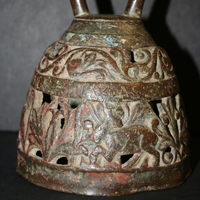
Bell
Unknown Artist
Probably Europe
Bell, 15th-17th century
Bronze, polychrome, 5 1/2 inches x 4 1/2 inches diameter
Donor Unknown
This openwork bell features the symbols of Matthew, Mark, Luke, and John, with their Latin names inscribed on a band above the Man, Lion, Bull, and Eagle. The bell is meant to be suspended and struck with a mallet, likely during Mass or other Christian rites, as it is constructed without a clapper. The deformation of the bell, now almost in the shape of a rounded square at its base, indicates it was probably struck in this manner for many years.
More about this item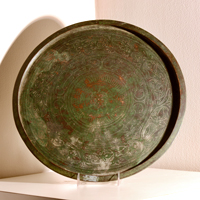
Tooled Plate
Unknown Hindu-Javanese Artist
Indonesia
Tooled Plate, 18th-19th century
Copper, 16 7/8 inches diameter x 1/2 inch high
Donor Unknown
The copper is so heavily oxidized on this plate that the engravings are difficult to discern. Visible elements resemble those on Indonesian shadow puppets, including foliate and animal motifs, tooling, and punchwork.
More about this item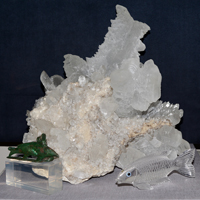
Fishes

Oxyrhynchus Fish
Unknown Artist
Egypt
Oxyrhynchus Fish, 570-350 BCE
Bronze, 4 1/2 x 2 1/8 x 1/2 inches
Gift of Mr. Leonard Epstein
Medjed was a species of elephant fish worshipped in ancient Egyptian religion. The elephant fish (family Mormyridae) are medium-sized freshwater fish abundant in the Nile. The elephant fish gets its name from its elongated downturned snout, which can be seen clearly in this example. A settlement in Upper Egypt, Per-Medjed, was named after the fish and is now better known under its Greek name Oxyrhynchus. Revered by the Egyptians, the Medjed is often seen with the horned disk on its head. This fish was likely worn as an amulet, as evidenced by the ring attached to the back of the headpiece.
More about this item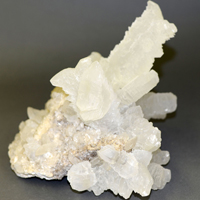
Gypsum
Gypsum
Laguna del Rey, Coahuila, Mexico
11 x 14 x 10 inches
Gypsum is a soft calcium sulfate mineral (hardness 2 out of 10), used as a fertilizer and as the main ingredient in plaster and drywall. This large “fishtail” crystal specimen was found in the early 1970s.
More about this item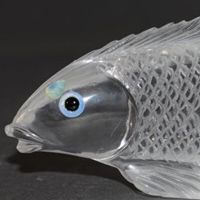
Quartz fish
Unknown Carver
Quartz fish
Carved in Brazil
2 1/2 x 6 1/2 x 1 inches
The quartz fish has carved scales and fins, and black onyx eyes with a surrounding opal ring.
More about this item
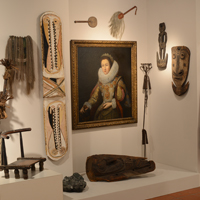
Power, Prestige & Protection
This cabinet symbolizes strength of purpose, royal privilege, and defense against enemies and evil. It is larger than life, as it contains objects of visual grandeur.
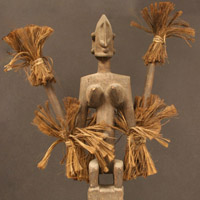
Satimbe
Unknown Dogon Artist
Mali, Africa
Satimbe, 20th century
Wood, fiber, paint, 40 3/4 x 18 x 6 inches
Gift of Geneva R. Steinberger
Satimbe masks from Mali are surmounted by a female figure representing the elder sister of the mask. It is a ceremonial mask used during the annual harvest festival (called Bulu), celebrated in all the villages before the rainy season. The rectangular lower portion is surmounted by this standing female figure with outstretched and moveable arms. The figure represents yasigine, the only woman admitted to the Awa male society. These few female members of Awa stand for the collective woman who, in origin stories, first discovered masks.
More about this item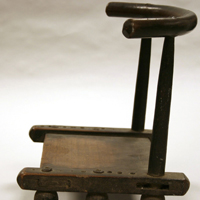
Country Chair
Unknown Vai Maker
Liberia, Africa
Country Chair, early to mid-20th century
Wood, brass, 15 1/4 x 20 1/4 x 12 inches
Gift of William C. Lickle
The Liberian Vai are known as skilled carpenters, weavers, farmers, and tailors. This chair shows the skill of the Vai carpenter in its bentwood back and the joinery of the seat. “Found” elements are seen in the details, such as the brass tacks and lathe-turned legs and are assimilated into the design. Chairs and stools in many African cultures denote stature, and it is an honor to be able to sit on a seat elevated from the ground.
More about this item![Bukwas [Wild Man of the Woods]](https://exhibitions.lib.udel.edu/collectors-cabinet/wp-content/uploads/sites/234/2021/02/091_thumb.jpg )
Bukwas [Wild Man of the Woods]
Elroy Keepness (Kwakwaka’wakw, dates unknown)
Bukwas [Wild Man of the Woods], 1993
Wood, paint, hair (musk ox?), 24 inches (including hair) x 7 1/4 x 6 1/4 inches
Gift of Frederick and Lucy Herman Native American Collection
This object comes from the Pacific Northwest. Bukwas, or Wild Man of the Woods, is a significant supernatural spirit being and casts a haunting figure in the Kwakwaka’wakw great annual winter dance. He resembles a gaunt, haggard, wild man, dressed in ragged garments with long, disheveled hair. He is a small green spirit whose face looks emaciated like a skeleton and has a long curving nose. Bukwas lives in the deep forests and tries to bring the living over to the world of the dead. He is a spirit of the dead identified with an afterlife realm inhabited by various ghosts, especially the souls of those who have drowned.
More about this item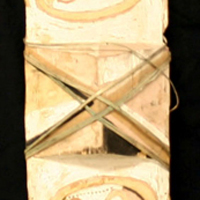
War Shield
Unknown Mengen Maker
New Britain, Melanesia
War Shield, early 20th century
Wood, rattan, polychrome, 61 1/8 x 10 7/8 inches
Gift of Cedric H. Marks
The Mengen people live on the south coast of New Britain, near Jaquinot Bay. Their art-making tradition includes producing ceremonial shields made from wood and woven fiber, which were carved in low relief and painted with red, white, and black pigment. Like the Asmat example on view (similar to object 88 in this cabinet), this shield is a war shield, with a triangular carved handle on the back covered in patterned woven rattan.
More about this item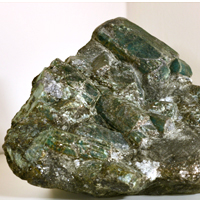
Emerald
Emerald
Bahia, Brazil
11 x 12 x 5 inches
Emerald, the green variety of the mineral beryl, was first discovered in Egypt and was mined there as early as 1500 BCE. Cleopatra adorned herself and her palace with emeralds in a display of wealth and power. Emeralds were later discovered by Spanish explorers in the 16th century in what is now Colombia, although the emeralds had been used for jewelry and religious ceremonies by the Incas for 500 years. During their filming of the movie Cleopatra, Richard Burton bought Elizabeth Taylor an emerald brooch, which became one of many that she owned. In 2011, one of her emerald pendants sold at auction for more than six million dollars.
More about this item
Canoe Bowsprit
Unknown Iatmul Maker
Papua, New Guinea
Canoe Bowsprit, 20th century
Wood, 30 1/2 x 16 1/2 x 9 inches
Gift of Miss Ingeborg de Beausecq
Crocodiles play a central role in the art and culture of the Iatmul people, who reside in the middle Sepik River region of Papua, New Guinea. According to one Iatmul creation account, an ancestral crocodile was responsible for forming the land. In the beginning, the earth was covered by a primordial ocean. The crocodile dove into the ocean, and when he surfaced, he brought a quantity of mud with him, forming land.
This boat prow was probably from a war or transport canoe, which could hold ten to twenty men, and was hewn from a single log. The crocodile figures prominently on this bowsprit as does the ferocious beaked face representing a revered ancestor figure.
More about this item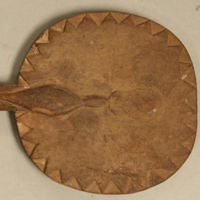
Scepter
Unknown Bamum/Bamoun Maker
Cameroon, Africa
Scepter, 20th century
Wood, 12 5/8 x 5 1/8 inches
Gift of William C. Lickle
This double-sided, low-relief carved paddle features symbols important to the Bamum/Bamoun people. A double-sided depiction of an ancestral skull is carved at the base of the handle. A spiritual animal, either a chameleon or crocodile, is shown at the joining of the disk and handle.
More about this item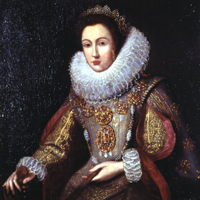
Portrait of Queen Elizabeth I
Unknown Artist
Great Britain, 17th or 18th century
Portrait of Queen Elizabeth I
Oil on canvas 35 3/4 x 31 1/2 inches
Gift of Ellen duPont Wheelwright Estate
Elizabeth I was Queen of England and Ireland from November 17, 1558 until her death on March 24, 1603. Sometimes called the Virgin Queen, Gloriana, or Good Queen Bess, Elizabeth was the last of the five monarchs of the House of Tudor. A cult grew around her and she was celebrated in the portraits, pageants, and literature of the day, and her notoriety has extended to portraits such as this and even to contemporary novels and films.
More about this item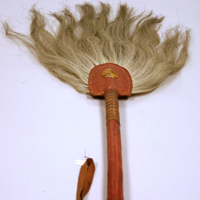
Flywhisk
Unknown Maker
Africa
Flywhisk, 19th-20th century
Leather, animal hair, 27 1/2 x 9 1/2 inches
Gift of the Carpenter Collection
Flywhisks appear frequently in many parts of the African continent. Collection records indicate that this one is probably from East Africa, either from Ethiopia or Kenya. Similar whisks are found among the Zulu in the south and Yoruba in the west. In addition to the practical aspect of shooing away flies, a flywhisk is also a symbol of power and nobility. Horsehair is usually the choice for the whisk, as horses are also symbols of influence and stature. The hair on this whisk may indeed be horsehair, but its softness and fine tresses may indicate another species such as a wildebeest beard.
More about this item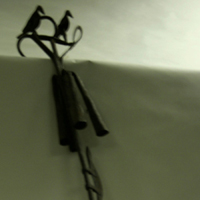
Opa Orere Diviner’s Staff
Unknown Yoruba Artist
Nigeria, Africa
Opa Orere Diviner’s Staff, early 20th century
Iron, 51 7/8 inches high
Gift of Mr. & Mrs. Arnold Saltzman
The opa orere (also called opa osun or opa osungaga) is used by Yoruba babalawos (diviners) as a symbol of office but also as an altar to the divination god Orunmila. During Orunmila ceremonies, the babalawo leads the procession through the village carrying his opa orere. To let the staff fall is to invite the wrath of Orunmila. The babalawo must ensure that the staff remains erect to receive full blessings from the god. When not in use, the staff is stuck into the ground in front of the babalawo’s house and protects the babalawo while he sleeps.
More about this item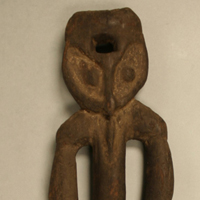
Anthropomorphic Suspension Hook
Unknown Maker
New Guinea
Anthropomorphic Suspension Hook, early 20th century
Wood, 22 x 7 3/8 inches
Gift of Alan Gerdau
A suspension hook such as this was probably hung in a men’s tribal house as a sculptural element rather than for a utilitarian purpose. Artists of the Kopar and Angoram people, who live near the mouth of the Sepik River in northern New Guinea, created distinctive openwork figures portraying powerful spirits with long beak-like noses and lithe, attenuated bodies, much like this example.
More about this item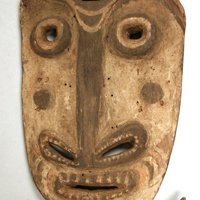
Suspension Hook/Mask
Unknown Sepik River Maker
Papua, New Guinea
Suspension Hook/Mask, early 20th century
Wood, polychrome, 22 7/8 x 12 1/2 inches
Gift of Mr. Alan Gerdau
Suspension hooks like this one have both utilitarian and ceremonial functions in Papua, New Guinea. Suspended from the rafters by a cord, they are used to safeguard food, clothing, and other items. Baskets or string bags are filled and hung from the hook-shaped prongs at the base to keep them out of reach of vermin. Most hooks are adorned with representations of ancestral spirits and totemic animals associated with the owner’s clan. Given the size and ferocity of this shield-like face, this suspension hook was probably both utilitarian and a protector of the home.
More about this item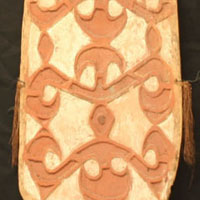
War Shield
Unknown Asmat Maker
New Guinea
War Shield, early 20th century
Wood, fiber, polychrome, 74 1/4 x 19 1/2 inches
Gift of Mr. Samuel Rubin
The Asmat inhabit a vast swamp on the south coast of the island of New Guinea in the Indonesian province of Papua (also called West Papua, formerly Irian Jaya). Tribal warfare and headhunting historically played an important role in Asmat culture and religion. Shields (jamasj) offer protection from both the physical and spiritual powers of the enemy. Shield motifs, and the ancestor for whom a shield is named, give its owner power. Headhunting symbols are common on many shields, and this shield, for example, features the flying fox in red and white ochre, a symbol associated with headhunting.
More about this item
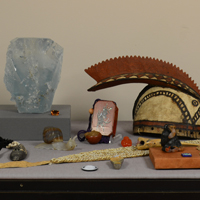
Jewels, Adornments, & Keepsakes
The tradition of adornment and gathering treasures is as old as time itself. Often signifying wealth and power, personal objects most importantly evoke joy, remembrances, and beauty for beauty’s sake. Some of these objects are functional, some are ostentatious, while others ensure good fortune and longevity.
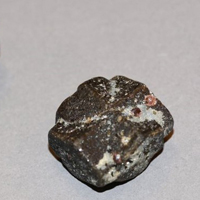
Staurolite
Staurolite
Taos, Taos County, New Mexico
1 x 1 inches
The name staurolite comes from the Greek stauro for cross and lithos for stone, as staurolite often has twin crystals that cross each other. Also called “fairy crosses,” they are often kept as good luck charms.
More about this item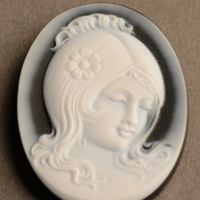
Cameo
Erwin Pauly (Idar-Oberstein, Germany, b. 1934)
Cameo
Agate, 30 x 40 x 3 mm
Gift of Mr. and Mrs. Harold B. Frosh
Most cameos are made from shell, which is much softer and easier to work with than the hardstone cameo shown. The agate material was layered, and a portion of the top white layer was carved away, leaving the finely detailed portrait. The cameo of a girl with a flower in her hair is signed Venus Erwin Pauly W. Germany.
More about this item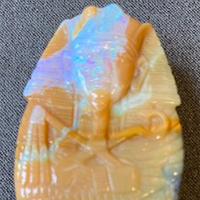
Opal sarcophagus
Unknown Carver
Opal sarcophagus
1 x 2 3/4 x 1/2 inches
Gift of Mr. & Mrs. Harold B. Frosh
This is a miniature opal carving of a sarcophagus, which was a coffin used in ancient burials.
More about this item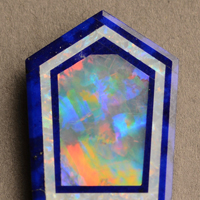
Intarsia
Jim Kaufmann (United States, dates unknown)
Intarsia
Opal and lapis lazuli, 18 x 25.5 x 3 mm
The intarsia is similar to mosaic inlay, but on a much smaller and more precise scale.
More about this item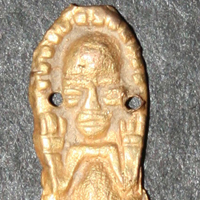
Tumbaga Objects
Unknown Artist(s)

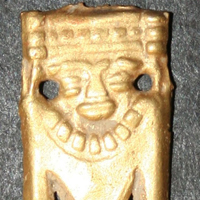
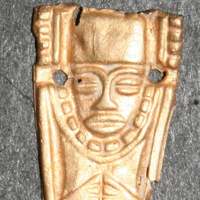
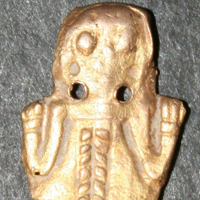
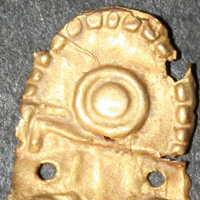
Colombia, South America
Tumbaga Objects, early 20th century
Gold/copper alloy, various sizes ranging from 1 inch to 4 inches in length
Gift of Lammot duPont
Tumbaga is the name given by Spanish Conquistadors for an alloy of gold and copper that was widely used by the pre-Columbian cultures of South and Central America. These are likely repoussé necklace parts, indicated by the perforations seen at the periphery of each. These are warrior-priest figures and a frog, a revered spirit-animal.
More about this item
Chimpanzee
Gerd Dreher (Idar-Oberstein, Germany, 1939-2018?)
Chimpanzee
Agate, 1 3/4 x 2 x 1 3/4 inches
Master carver Gerd Dreher created this chimpanzee from one piece of agate, taking advantage of the color banding in the material. Unique in his approach, he compiled a massive library of animal images and videos in order to study the movement and musculature for each animal he planned to carve. Dreher was a fourth-generation carver from Idar-Oberstein, Germany, whose grandfather and great-grandfather carved for Fabergé. His one-piece carvings and his detailed style was his own and his son, Patrick, continues in this same style.
More about this item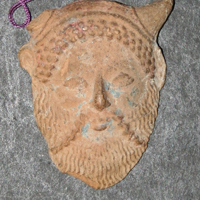
Appliqué of a River God (Acheloos?)
Unknown Etruscan Artist
Tuscany, Italy
Appliqué of a River God (Acheloos?), 480-470 BCE
Terracotta, 1 5/8 x 1 7/8 inches
Gift of Mr. & Mrs. Arnold Saltzman
This male head with bullhorns has traces of red and blue paint and white engobe (liquid clay slip) encrustation. The curved shape of the appliqué and the paint fragments suggest it may have been part of a vase. In Greek mythology, Achelous (Acheloos in Etruria) was the patron deity of the “silver-swirling” Achelous River, which is the largest river in Greece. Achelous is thus the chief of all river deities. This appliqué is consistent with other river god images found in the region.
More about this item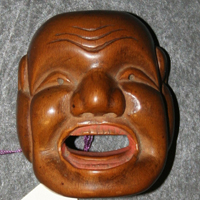
Netsuke
Unknown Japanese Carver
Netsuke, before 1960
Wood, paint, 1 7/8 x 1 5/8 inches
Gift of Mrs. Arthur Brin
Invented in 17th century Japan, netsuke, like this one, were attached to the obi (sash) of the kimono. Boxes such as inro hung from these carved wood or ivory toggles. An example of an inro is on view nearby. These boxes stored coins, medicine, cosmetics, or other necessities.
More about this item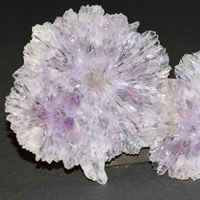
Quartz (amethyst)
Quartz (amethyst)
Irai, Rio Grande do Sul, Brazil
4 x 7 1/2 x 2 inches
Estate of Frederick A. Keidel
This double “flower” of amethyst is from the only locality known for this formation. The flower is formed by hundreds of individual crystals radiating from the center.
More about this item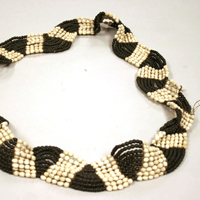
Bandolier
Unknown Gran Pajanal Maker
Peru
Bandolier, mid-20th century
Job’s tears seeds, black canna seeds, 55 inches circumference
Gift of Dr. & Mrs. Russell J. Seibert
The Gran Pajanal (Great Grassland or Great Savannah) is an isolated interfluvial plateau in the Amazon Basin of Peru, inhabited by the Asháninka or Ashéninka people, as well as immigrants from the Andes Mountains. This bandolier was worn as a decorative shoulder sash and is unusually ornate and intricate. Many others were simply formed of multiple strands of coiled vegetable fibers.
More about this item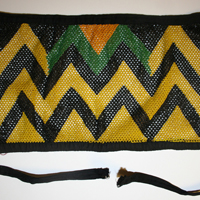
Beaded Apron
Unknown Vai Maker
Liberia, Africa
Beaded Apron, mid-20th century
Cotton, glass beads, 12 1/2 x 44 1/2 inches (including ties)
Gift of Mrs. Rose Joseph
This apron is worn by a woman when she is initiated into the Bundu or Sande society. Although the Sande society is usually associated with the Mende of Sierra Leone, practitioners are found among the Vai, who inhabit southeastern Sierra Leone. Sande emphasizes the political and social interests of women and its complementary society is that of the male dominated Poro. The Sande or Bundu society features a highly structured and stratified female leadership, highlighting the unusual social position of women in this region.
More about this item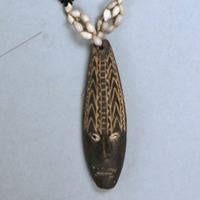
Amulet Necklace
Unknown Asmat Maker
Sepik River, Papua, New Guinea
Amulet Necklace, 20th century
Wood, paint, cowrie shells, seeds, 19 inches long
Gift of Camille B. Schiffman
This necklace, probably a tourist piece, is composed of seeds and small shells and terminates in a carved mask pendant of a typical teardrop shape seen in many Papuan masks. Faces adorning the necklace are concentrically carved, inpainted, and stained to achieve an abstracted and enigmatic expression. The intricate beadwork of alternating seeds and shells is typical of Asmat handwork.
More about this item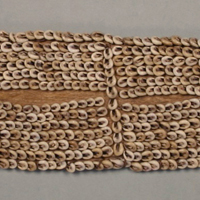
Headband
Unknown Asmat Maker
Middle Sepik River, New Guinea
Headband, early 20th century
Bark, shells, 26 1/8 x 3 3/8 inches
Gift of Camille B. Schiffman
The Sago palm found throughout New Guinea has many uses. Sago is primarily used in making flour from the starch in the pith in its stems. This staple is fundamental to the diet of many people in New Guinea. The palms also have fibrous sheaths at the base of the fronds, and this sheath or bark is pounded to make a kind of “bark” fabric. This headband is a prime example of this type of cloth, with the small shells chainstitched (an interlocking looped stitch resembling a chain) to the surface in the concentric rows often favored by Papuan men.
More about this item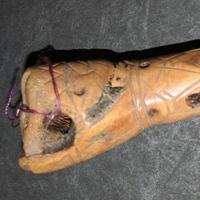
Pipe or Dagger Handle
Unknown Maker
Egypto-Roman (Coptic)
Pipe or Dagger Handle (ca. 150 CE)
Bone, 7 3/4 inches long
Unknown Donor
In the Egypto-Roman or Coptic period, bone was used extensively for utensils such as spoons, or for decorative objects. Many such objects were found in the Fayum Oasis region west of Cairo. This object could have been a pipe, although it is more likely that it served as the handle for a hammered copper dagger blade, as the clenched fist could symbolize fighting or combat.
More about this item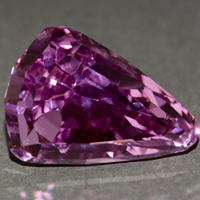
Spodumene (Kunzite)
Spodumene (Kunzite)
Brazil
40 x 55 x 45 mm, 614 carats
Gift of William K. and William M. Ryan
Named after George F. Kunz, who sold many minerals to Irénée du Pont, who left them to the University of Delaware, this mixed pear-cut kunzite (purple-pink color variety of the mineral spodumene) is of excellent clarity and fine color. Kunz was an American mineralogist and was considered to be the first gemologist.
More about this item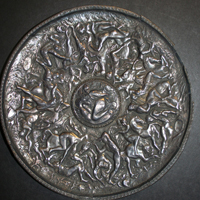
Repoussé Plate with Figures
Unknown Artist
Possibly Italy
Repoussé Plate with Figures, 17th-19th century
Silver, 7 1/2 inches diameter
Gift of Mr. Alan Gerdau
This silver repoussé plate features figures cavorting around the outer ring. In the center medallion there appears to be a kneeling nude. The subject might be satyrs and nymphs dancing around Bacchus, or it might depict men on horseback battling around the figure of a bound woman. This may have been a medallion attached to a larger object or platter; it is unlikely that this is a stand-alone object, as its thinness makes it very vulnerable, as evidenced by small tears around the edges.
More about this item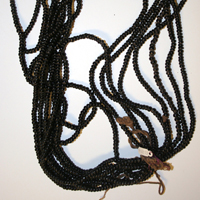
8-strand beaded necklace
Unknown Campa/Asháninka Maker
Peru
8-strand beaded necklace, mid-20th century
Black seeds, 32 inches long
Gift of Dr. & Mrs. Russell J. Seibert
When this object was donated to the collection, it came with the name “Campa,” an alternate and pejorative name for the Asháninka that is nonetheless still in use. The Campa/Asháninka speak a language belonging to the Arawak family. Most also speak Spanish and Quechua. This necklace is a typical example of everyday adornment; its seeds are similar to those of the canna plant.
More about this item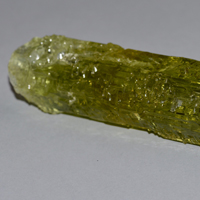
Beryl (heliodor)
Beryl (heliodor)
Volodarsk-Volynskii, Zhitomir Oblast, Ukraine, Russia
1 1/4 x 7 x 1 1/4 inches
Heliodor is the yellow color variety of the mineral beryl. The deposit that produced this heliodor was originally mined in the Soviet era for industrial-grade quartz. The quartz miners sometimes found beautiful gem-grade heliodor crystals and, not aware of their value, took them home to be used as decorations. In the 1980s, underground chambers about fifty feet tall were found, full of crystals. Beryl crystals generally have hexagonal outlines and smooth surfaces, but fluids in the mine, frequently acidic, etched the surface patterns seen on this crystal.
More about this item
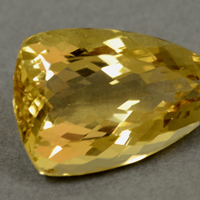
Beryl (heliodor)
Beryl (heliodor)
25 x 37 x 14.8 mm, 87.03 carats
Gift of John M. Levinson
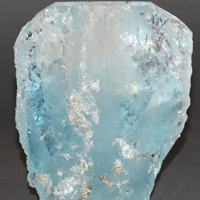
Topaz
Topaz
Xanda Mine, Virgem de Lapa, Minas Gerais, Brazil
6 3/4 x 5 1/2 x 3 inches
Estate of Mrs. David Craven
The Xanda Mine and the three other deposits in the area were discovered from 1939-1945. The miners followed the veins of beryl, tunneling underground and blasting with dynamite in the hard rock. The Xanda mine was a maze of tunnels, forcing miners to follow their instinct on where the gem pockets were thought to be located. This topaz is unusual for its large size, natural blue color, and intact crystal form. Much of the topaz used in jewelry today is not naturally blue but is irradiated to produce the color.
More about this item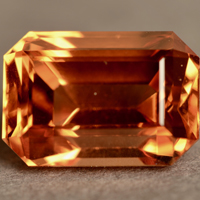
Topaz (Imperial)
Topaz (Imperial)
Ouro Preto, Brazil
11.1 x 19 x 12.1 mm, 22.25 carats
This step-cut imperial topaz (yellow) is the same mineral as the blue topaz shown with it. The yellow variety is much rarer than the blue variety.
More about this item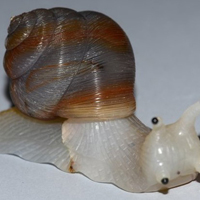
Snail
Emil Becker (Idar-Oberstein, Germany, dates unknown)
Snail
Agate, 2 x 3 1/2 x 1 1/2 inch
The snail is carved from two pieces of agate with a translucent cream-white agate for the body and a banded orange-brown agate for the univalve shell.
More about this item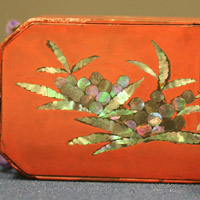
Lacquerware Box with Wood Bell Netsuke
Unknown Maker
Japan
Lacquerware Box with Wood Bell Netsuke, 20th century
Red lacquer, abalone nacre inlay, wood, pink coral ojime (bead), 3 1/8 x 1 1/2 inches
Gift of William M. Donaldson
Lacquerware objects such as boxes, vases, and pieces of furniture are made by applying layer upon layer of treated lacquer sap to a base of wood. Once applied by brush or immersion, the sap, which is thinned with tung oil and colored with minerals such as cinnabar, is allowed to dry in the dark until hard. After this, another layer of sap is applied, followed by another and then another. This exacting process is usually repeated scores of times. This box, worn suspended from the netsuke attached to the obi (sash), has a rich orange color and is inlaid with abalone nacre (mother of pearl). The netsuke takes the shape of a wooden bell, or, as it is sometimes called, a temple block. It is a musical instrument that when struck with a mallet makes a hollow clopping sound.
More about this item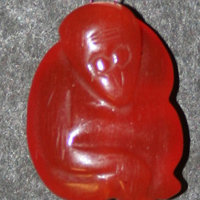
Seated Monkey Amulet
Unknown Carver of Kangxi Emperor, late Qing Dynasty
China
Seated Monkey Amulet, 1722 or later
Red Jade, 1 1/4 x 1 inches
Gift of Dr. & Mrs. Willi Riese
This amulet, like other animals represented in jade, has various meanings in China. The monkey, prized for its cunning and cleverness, is an example of how animals exemplify spirituality in nature.
More about this item![Bird Hat Mask [Wannoraogo]](https://exhibitions.lib.udel.edu/collectors-cabinet/wp-content/uploads/sites/234/2021/02/124-_thumb.jpg )
Bird Hat Mask [Wannoraogo]
Unknown Mossi/Mosi Carver
Burkina Faso, Africa
Bird Hat Mask [Wannoraogo], early to mid-20th century
Wood, polychrome, 7 3/4 x 5 x 15 7/8 inches
Gift of William C. Lickle
This mask represents one of the three major styles found among the Mossi, who live in the Ougadougou state in southwest Mossi territory. Like most masks of this type, the features are stylized, yet retain the recognizable identity of an animal, in this case, a rooster.
More about this item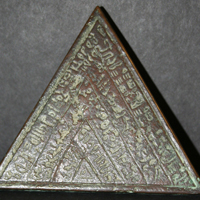
Bronze Triangle
Unknown Artist
Possibly Egypt
Bronze Triangle, possibly 380-363 BCE
Bronze, 3 x 3 1/2 inches
Unknown donor
Much conjecture surrounds the authenticity of this piece as an ancient Egyptian artifact. Some of the crude hieroglyphs in the inscription may indicate forgery, or they could have been added later. Other legible hieroglyphs might be ancient, lending credence to the possibility that the object is authentic. An approximate translation of the left cartouche reveals the name of King Nekhtanebo I, founder of the Thirtieth Dynasty (380-363 BCE). This object’s size and weight indicate it was not for personal adornment, but might have been hung from a tree or the neck of a bull, for example.
More about this item
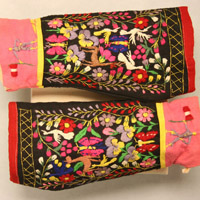
Pair of Gauntlets
Unknown Artist
Huancayo, Andes Miotiso Region, Peru
Pair of Gauntlets, mid-20th century
Cotton, 11 x 6 inches
Gift of Dr. & Mrs. Russell J. Seibert
Huancayo’s embroidery art dates from the Spanish colonization of 1534, and was used to adorn the dresses of the icons and statues of the Catholic Church. Prior to embroidering, drawings of flowers, doves, butterflies, or hummingbirds are prepared on paper, and are then transferred by hand or machine stitching using threads of deeply saturated color and high contrast. Blankets, gala dresses, skirts, pants, vests, cuffs, and other garments, such as these gauntlets, are covered in these designs. These gauntlets also feature a figure waving the Peruvian flag at the cuff. The gauntlets slide over the forearm and terminate just above the elbow. Normally a gathered shorter-sleeved blouse and skirt, both draped with an embroidered manta, completes the ensemble, topped with a colorful hat.
More about this item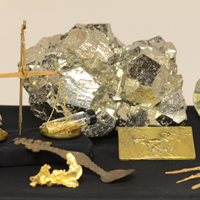
The Glitter of Gold
Gold (Au) is the most stable element on earth and has been valued throughout recorded history for jewelry, gold coins, and other art. It does not react to weathering or most acids, explaining why most all the gold ever mined still exists. About 50% of gold is fashioned into jewelry, 40% is invested, and 10% is used in industry. Its price has fluctuated greatly since 1971 when it was no longer fixed by law at $35 per ounce. Shown here are samples of native gold, pyrite (a mineral commonly called “fool’s gold”), artifacts plated with gold, and gold weights that are made of brass to use in the weighing of gold dust.
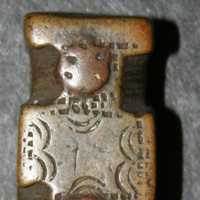
Gold Weight
Unknown Artist
Ashanti/Asante/Akan, Ghana, Africa
Gold Weights, various dates
Brass, sizes ranging from 5/8 to 3 1/2 inches in length
Gift of Mr. Harold Kaye
Gold’s importance as a commodity gave rise to Ghana’s old colonial name, the Gold Coast. Most merchants and high-ranking individuals used their personal weighing equipment to ensure a fair transaction, owning full sets of weights and related equipment. Gold weights most often were cast in brass or bronze, but they also sometimes were fashioned from other materials. The Akan system for weighing gold dust was based on North African, Dutch, Portuguese, and local measures, resulting in precisely calibrated weights. Gold was not only a means of wealth and a way of displaying status, but it was also a spiritual substance. The glittering metal was considered the earthly embodiment of the sun (kra), and thus the force of life itself.
More about this item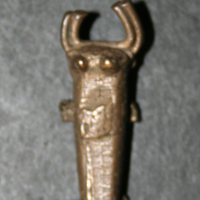
Gold Weight
Unknown Artist
Ashanti/Asante/Akan, Ghana, Africa
Gold Weights, various dates
Brass, sizes ranging from 5/8 to 3 1/2 inches in length
Gift of Mr. Harold Kaye
Gold’s importance as a commodity gave rise to Ghana’s old colonial name, the Gold Coast. Most merchants and high-ranking individuals used their personal weighing equipment to ensure a fair transaction, owning full sets of weights and related equipment. Gold weights most often were cast in brass or bronze, but they also sometimes were fashioned from other materials. The Akan system for weighing gold dust was based on North African, Dutch, Portuguese, and local measures, resulting in precisely calibrated weights. Gold was not only a means of wealth and a way of displaying status, but it was also a spiritual substance. The glittering metal was considered the earthly embodiment of the sun (kra), and thus the force of life itself.
More about this item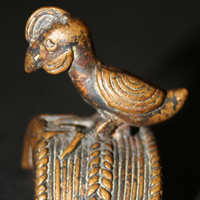
Gold Weight
Unknown Artist
Ashanti/Asante/Akan, Ghana, Africa
Gold Weights, various dates
Brass, sizes ranging from 5/8 to 3 1/2 inches in length
Gift of Mr. Harold Kaye
Gold’s importance as a commodity gave rise to Ghana’s old colonial name, the Gold Coast. Most merchants and high-ranking individuals used their personal weighing equipment to ensure a fair transaction, owning full sets of weights and related equipment. Gold weights most often were cast in brass or bronze, but they also sometimes were fashioned from other materials. The Akan system for weighing gold dust was based on North African, Dutch, Portuguese, and local measures, resulting in precisely calibrated weights. Gold was not only a means of wealth and a way of displaying status, but it was also a spiritual substance. The glittering metal was considered the earthly embodiment of the sun (kra), and thus the force of life itself.
More about this item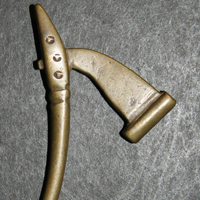
Gold Weight
Unknown Artist
Ashanti/Asante/Akan, Ghana, Africa
Gold Weights, various dates
Brass, sizes ranging from 5/8 to 3 1/2 inches in length
Gift of Mr. Harold Kaye
Gold’s importance as a commodity gave rise to Ghana’s old colonial name, the Gold Coast. Most merchants and high-ranking individuals used their personal weighing equipment to ensure a fair transaction, owning full sets of weights and related equipment. Gold weights most often were cast in brass or bronze, but they also sometimes were fashioned from other materials. The Akan system for weighing gold dust was based on North African, Dutch, Portuguese, and local measures, resulting in precisely calibrated weights. Gold was not only a means of wealth and a way of displaying status, but it was also a spiritual substance. The glittering metal was considered the earthly embodiment of the sun (kra), and thus the force of life itself.
More about this item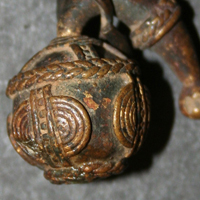
Gold Weight
Unknown Artist
Ashanti/Asante/Akan, Ghana, Africa
Gold Weights, various dates
Brass, sizes ranging from 5/8 to 3 1/2 inches in length
Gift of Mr. Harold Kaye
Gold’s importance as a commodity gave rise to Ghana’s old colonial name, the Gold Coast. Most merchants and high-ranking individuals used their personal weighing equipment to ensure a fair transaction, owning full sets of weights and related equipment. Gold weights most often were cast in brass or bronze, but they also sometimes were fashioned from other materials. The Akan system for weighing gold dust was based on North African, Dutch, Portuguese, and local measures, resulting in precisely calibrated weights. Gold was not only a means of wealth and a way of displaying status, but it was also a spiritual substance. The glittering metal was considered the earthly embodiment of the sun (kra), and thus the force of life itself.
More about this item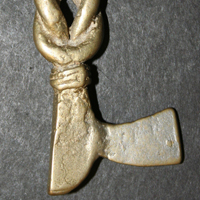
Gold Weight
Unknown Artist
Ashanti/Asante/Akan, Ghana, Africa
Gold Weights, various dates
Brass, sizes ranging from 5/8 to 3 1/2 inches in length
Gift of Mr. Harold Kaye
Gold’s importance as a commodity gave rise to Ghana’s old colonial name, the Gold Coast. Most merchants and high-ranking individuals used their personal weighing equipment to ensure a fair transaction, owning full sets of weights and related equipment. Gold weights most often were cast in brass or bronze, but they also sometimes were fashioned from other materials. The Akan system for weighing gold dust was based on North African, Dutch, Portuguese, and local measures, resulting in precisely calibrated weights. Gold was not only a means of wealth and a way of displaying status, but it was also a spiritual substance. The glittering metal was considered the earthly embodiment of the sun (kra), and thus the force of life itself.
More about this item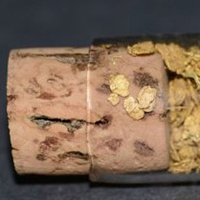
Gold in vial
Gold in vial
Sapphire Mine, Yogo Gulch, Judith Basin County, Montana
2 inches (vial)
Estate of Irénée du Pont
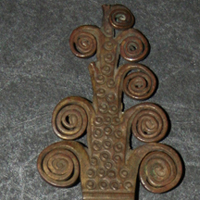
Gold Dust Measuring Spoon
Unknown Artist
Ashanti/Asante/Akan, Ghana, Africa
Gold Dust Measuring Spoon, early 20th century
Brass, 5 5/8 x 1 1/2 inches
Gift of Mr. Harold Kaye
Akan gold production probably began in the second half of the fifteenth century. Until 1901, gold circulated in powdered form, sika future, as the currency of the Asante Empire and many of its neighbors. In transactions and commercial exchanges in the market, gold dust was ladled onto a scale using brass spoons and weighed with cast-brass weights of varying sizes. This particular spoon, however, appears to be composed primarily of copper. In addition to the uniqueness of the metal from which it is made, ornate whorls and incised decoration further indicate the importance of the spoon’s owner.
More about this item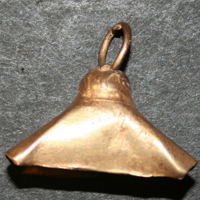
Tumbaga Objects

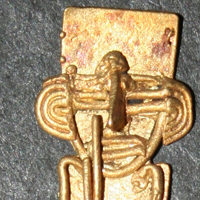
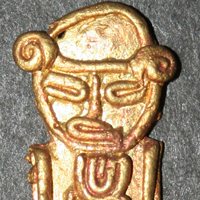
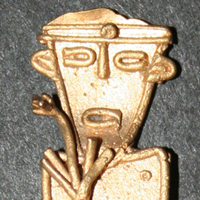
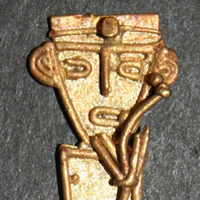
Unknown Artist(s)
Colombia, South America
Tumbaga Objects, date unknown
Gold/copper alloy, various sizes ranging from 1 inch to 4 inches in length
Gift of Lammot duPont
Tumbaga is the name given by Spanish Conquistadors for an alloy of gold and copper, which was widely used by the pre-Columbian cultures of South and Central America to make objects such as the examples seen here. The wide-ranging use of this alloy was quite versatile, and it was manipulated in many ways such as lost wax casting, raising, and soldering. Because the proportions of the alloy’s composite metals are inconsistent, and objects are sometimes gilded or washed in saline solutions, the color varies in hue from reddish gold to bright yellow gold.
More about this item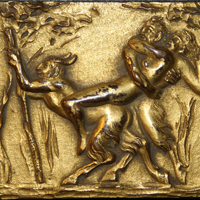
Plaque, Satyrs and Nymph, 17th-19th century
Unknown Artist
Padua, Italy
Plaque, Satyrs and Nymph, 17th-19th century
Bronze, gilding, 2 1/4 x 3 3/8 inches
Gift of Mr. Alan Gerdau
A nymph in ancient Greek and Roman folklore is a minor female deity. Different from goddesses, nymphs are personifications of nature, typically associated with a specific place or landform, and usually depicted as beautiful maidens. Satyrs, seen here in Roman form, are depicted as fauns with goat legs and horns. They love to dance with the nymphs with whom they are obsessed and whom they often pursue. Representations of satyrs cavorting with nymphs are common in Western art. The usage of this small plaque is unclear, but similar examples appeared as book cover inlays, commemorative medals, or architectural decoration.
More about this item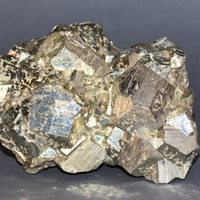
Pyrite
Pyrite
Peru
6 x 8 x 4 inches
Estate of Mrs. David Craven
Pyrite, an iron sulfide, is a very common mineral throughout the world; there are many deposits of pyrite in Peru spread over the entire country. Without documentation, it is impossible to know where this Peruvian specimen was mined. Often called “fool’s gold,” it is easily distinguished from gold by its lighter weight and greater hardness, and unlike gold it cannot be scratched with a knife.
More about this item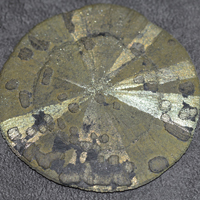
Pyrite
Pyrite
Sparta, Randolph County, Illinois
3 x 3 x 1/4 inches
Pyrite disk-like formations, called pyrite suns or pyrite dollars, are crystalline pyrite. The pyrite grows between layers of shale and is flattened by the weight of the overlying sediments. The Sparta area, where many thousands have been collected, is the most prolific locality.
More about this item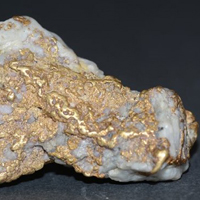
Gold in quartz
Gold in quartz
California
1 x 2 1/4 x 3/4 inch nugget
Estate of Irénée du Pont


 Close
Close
